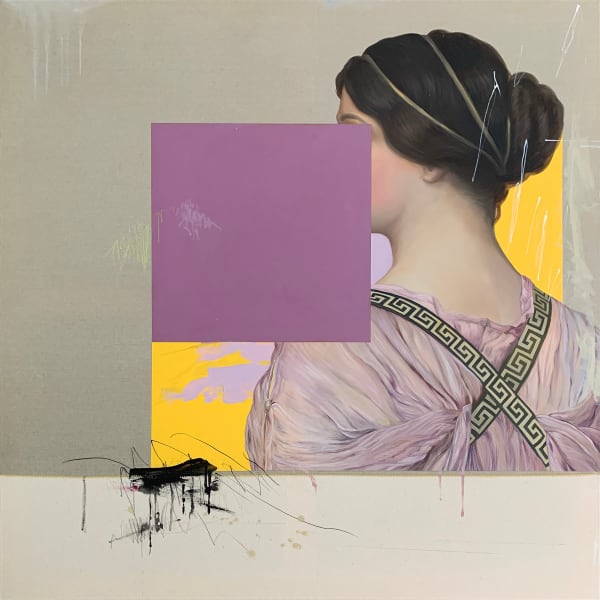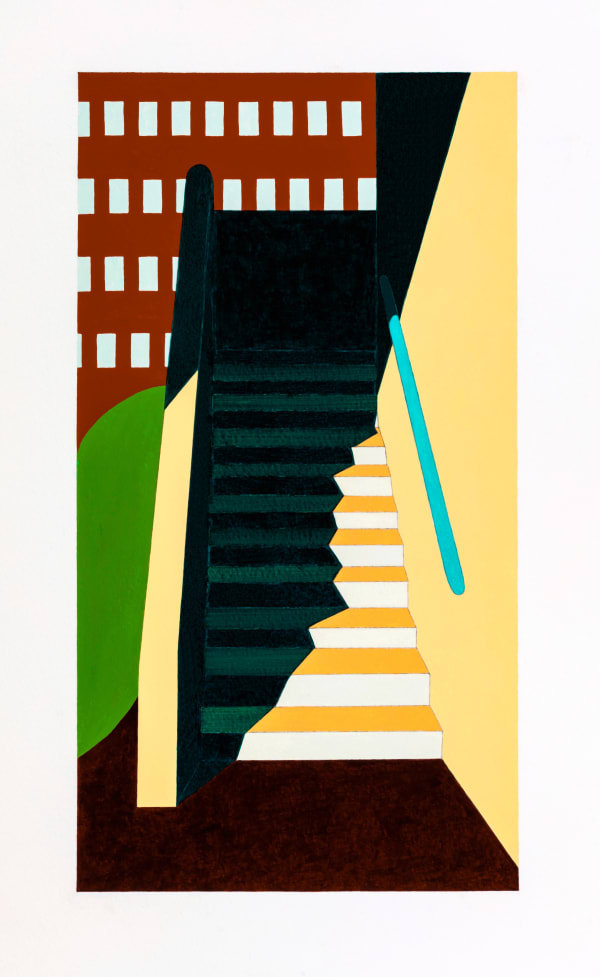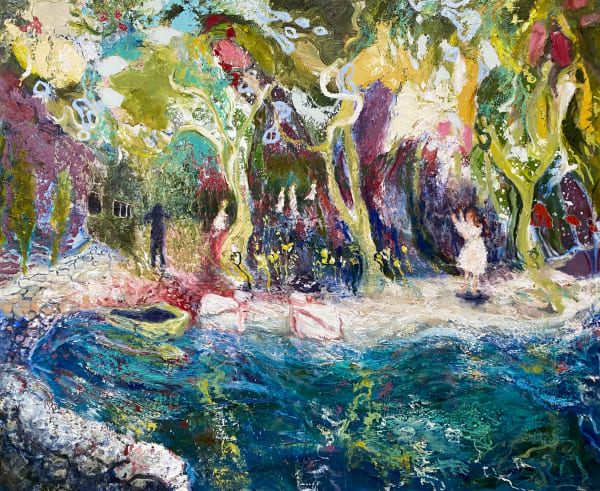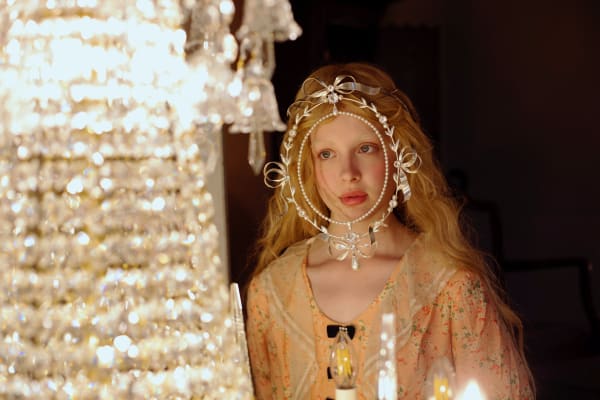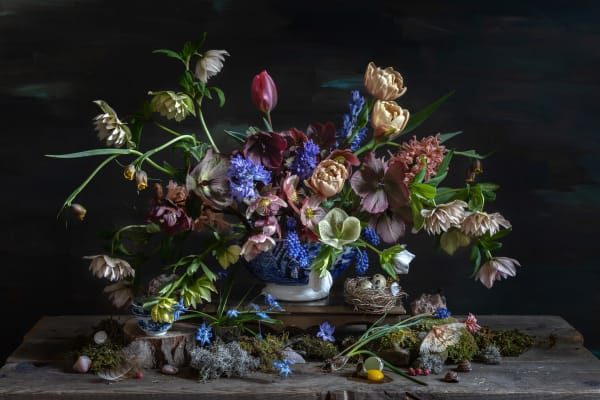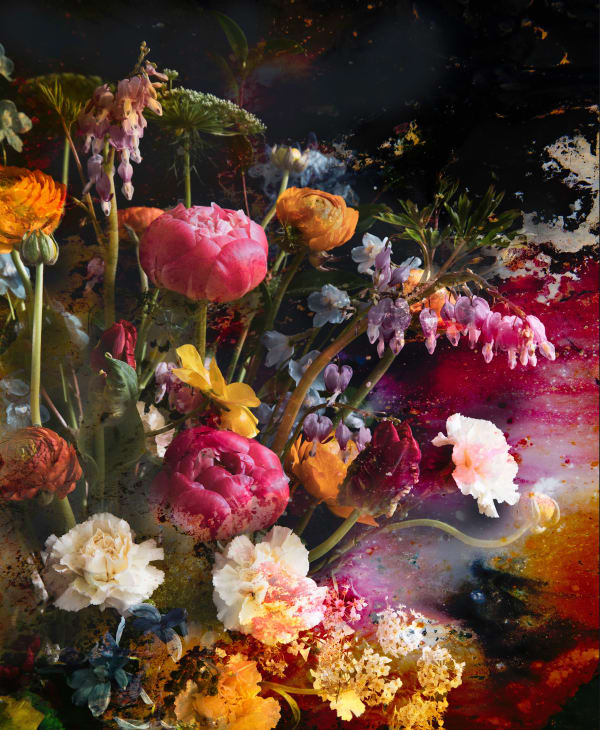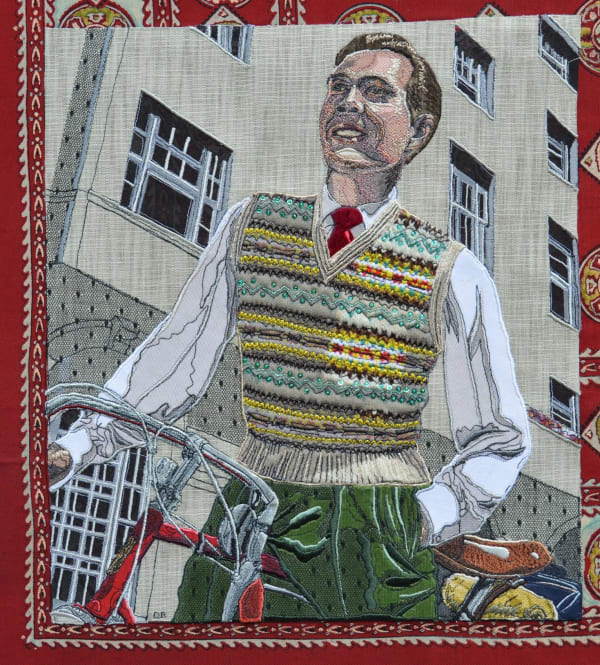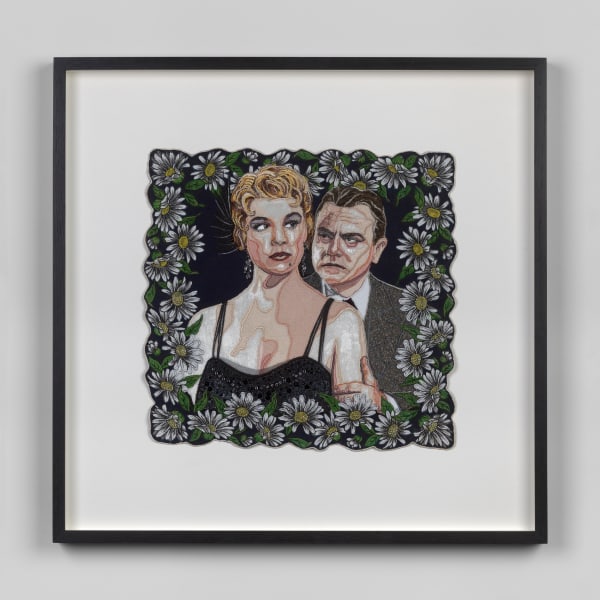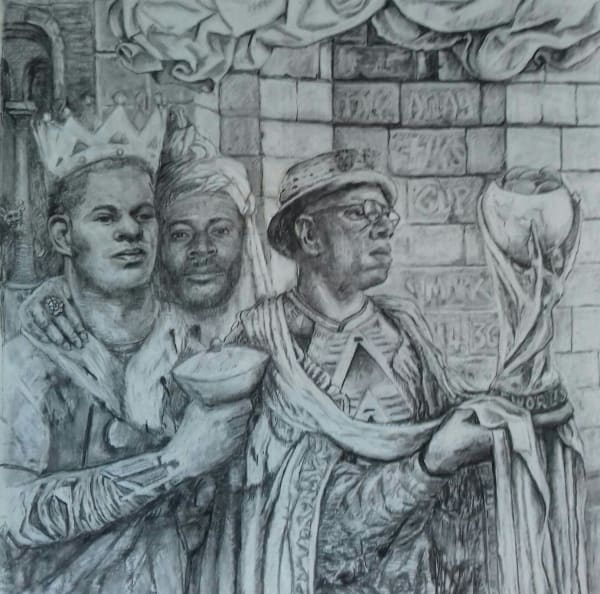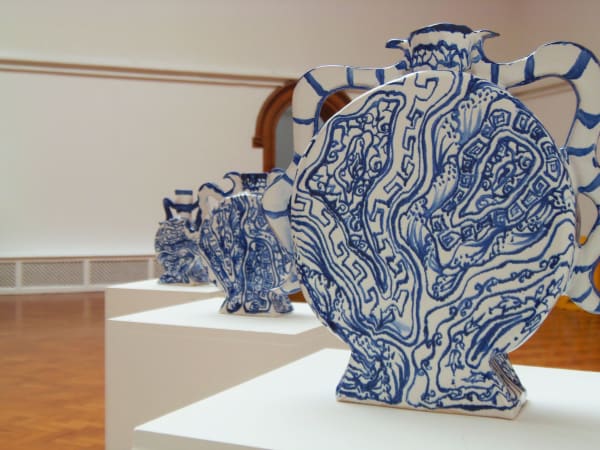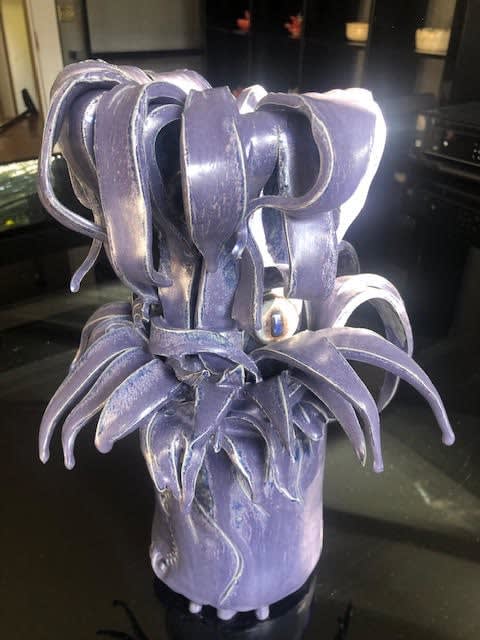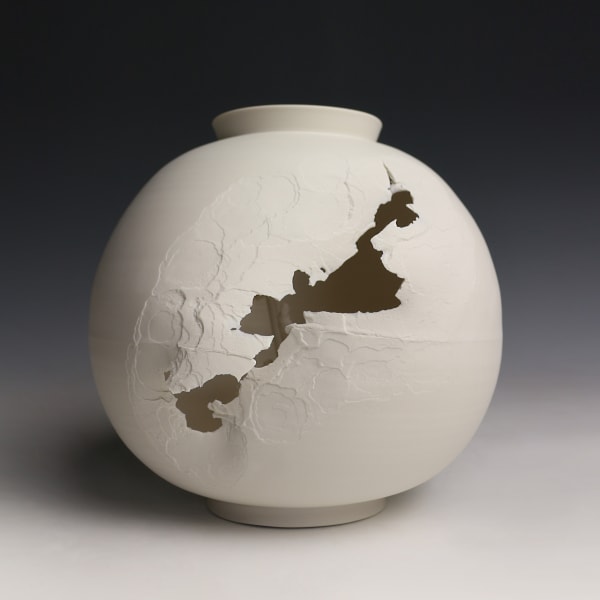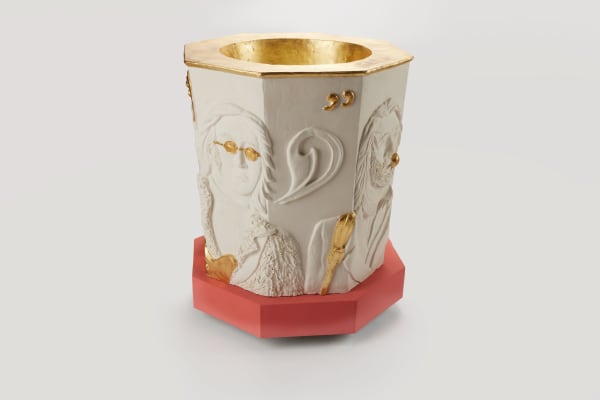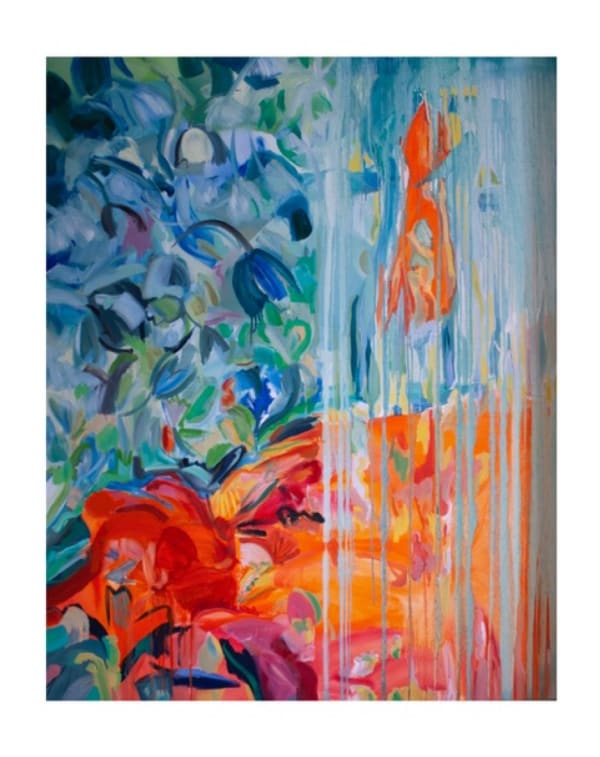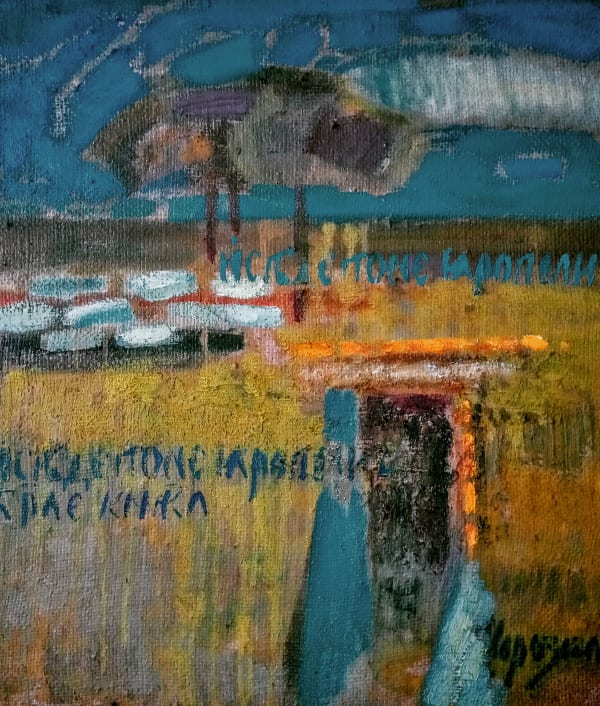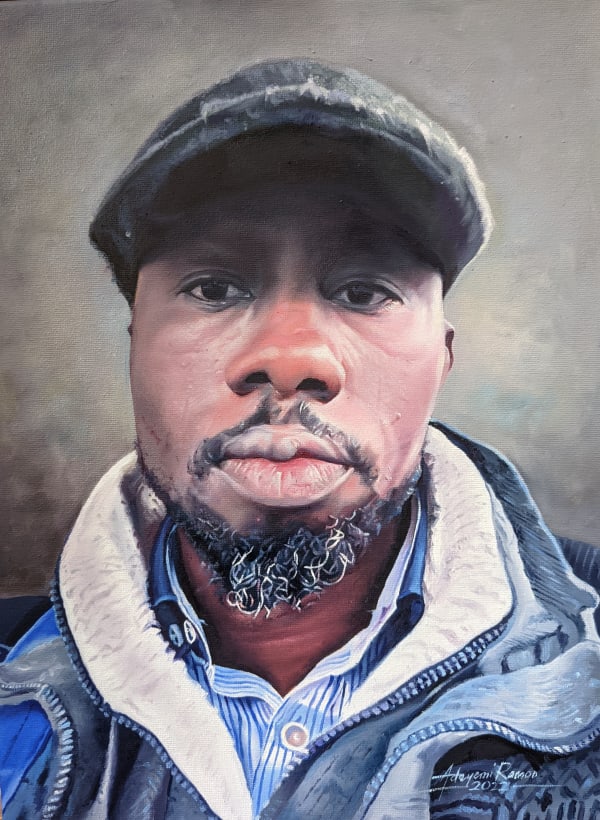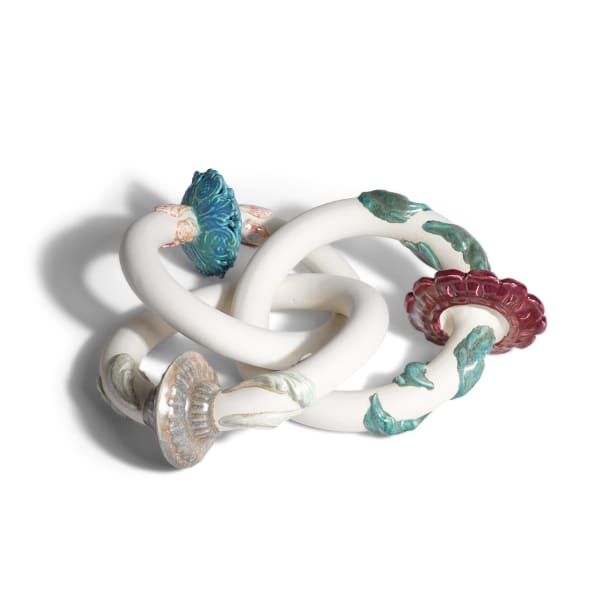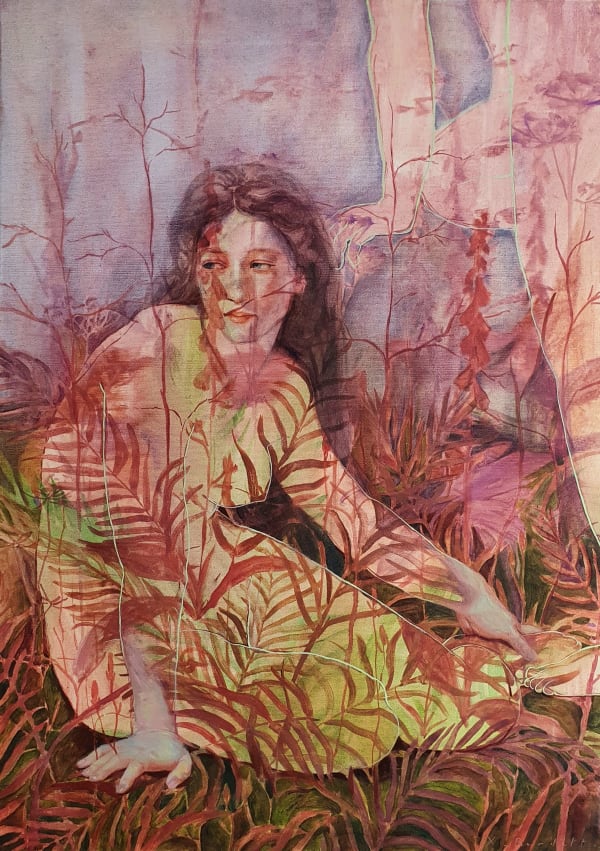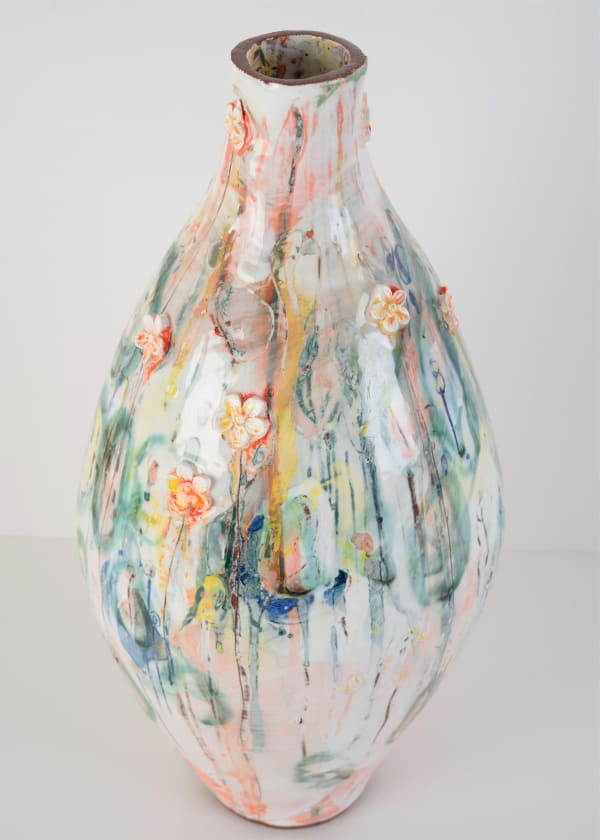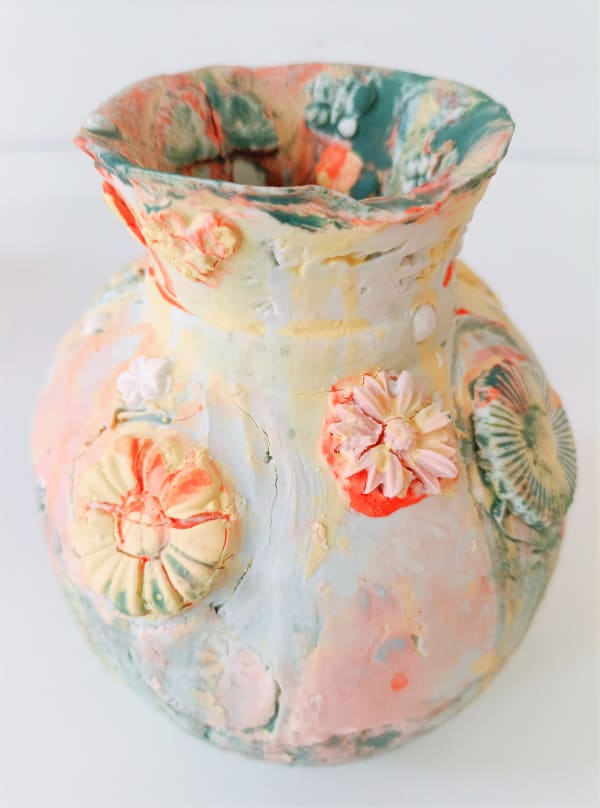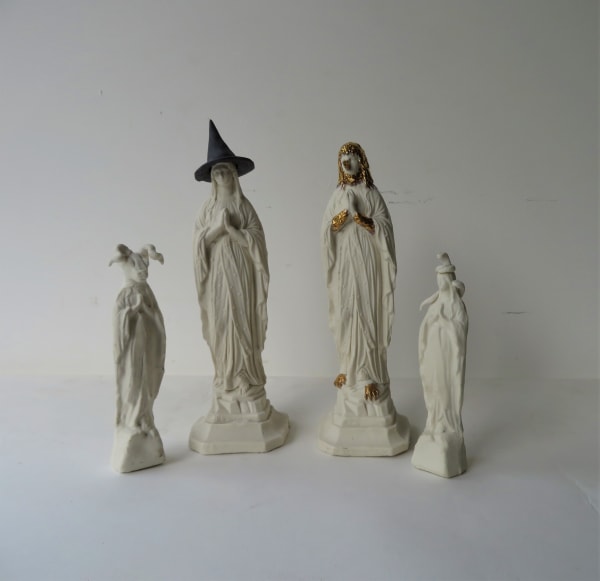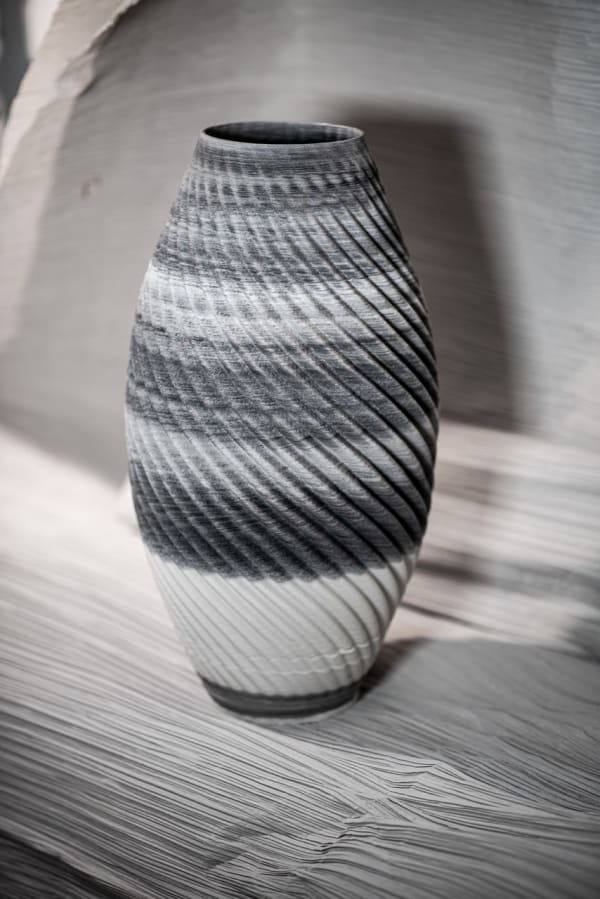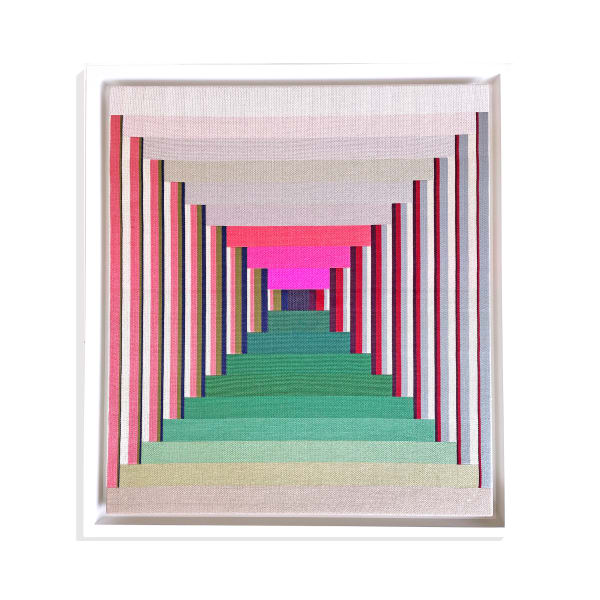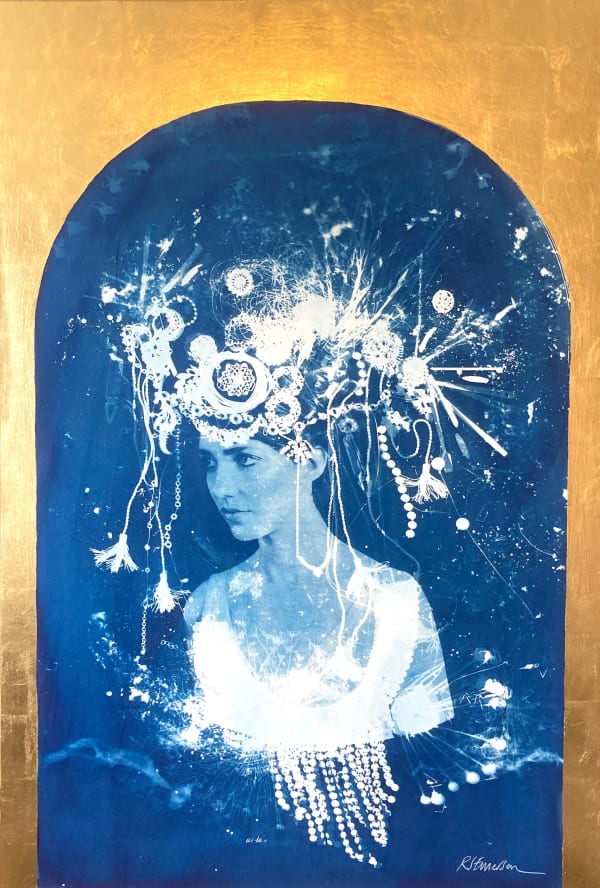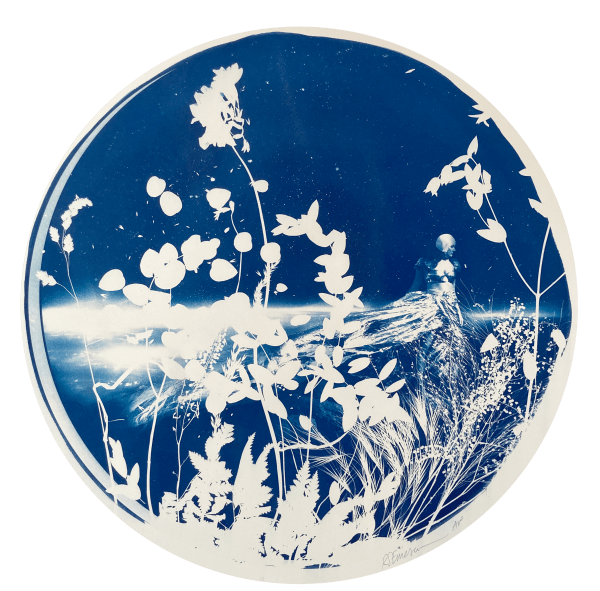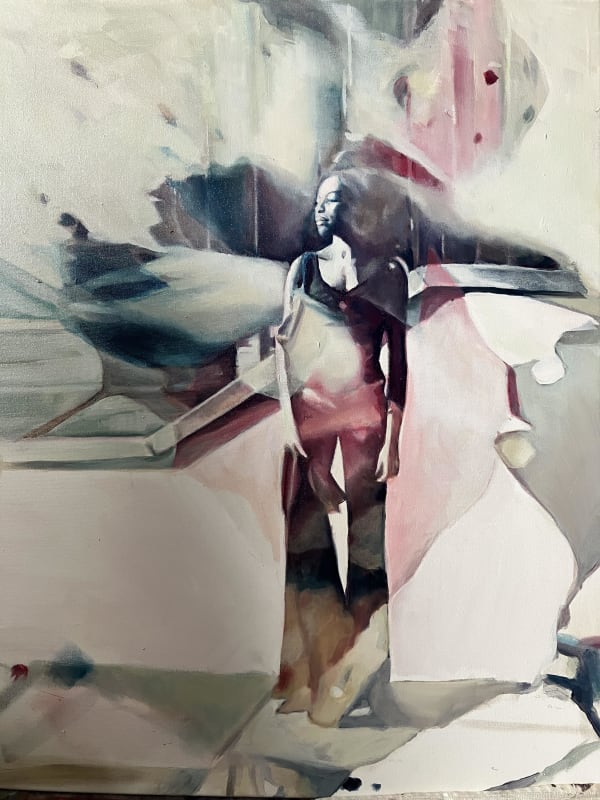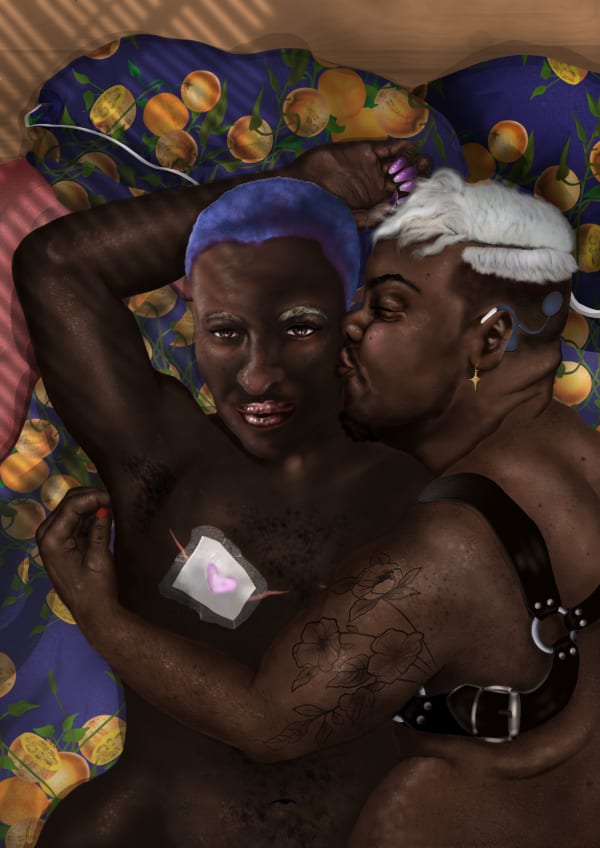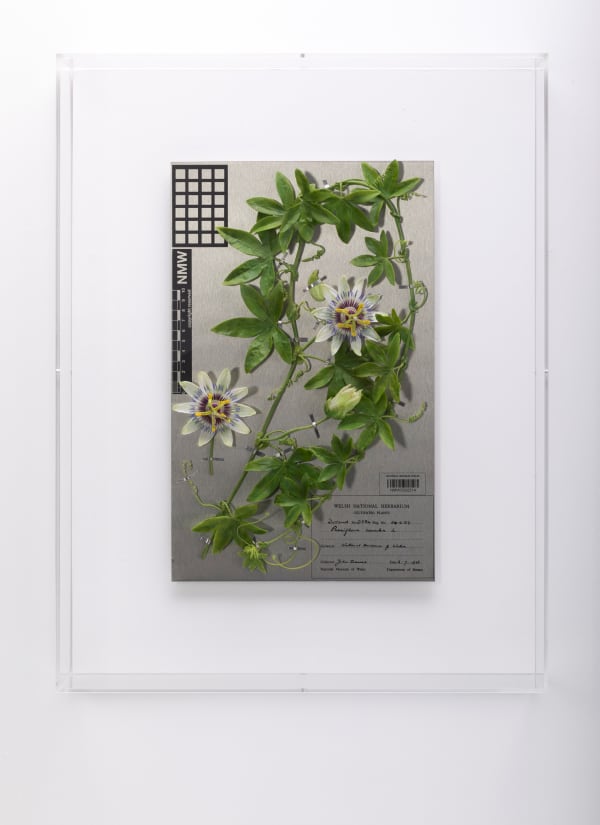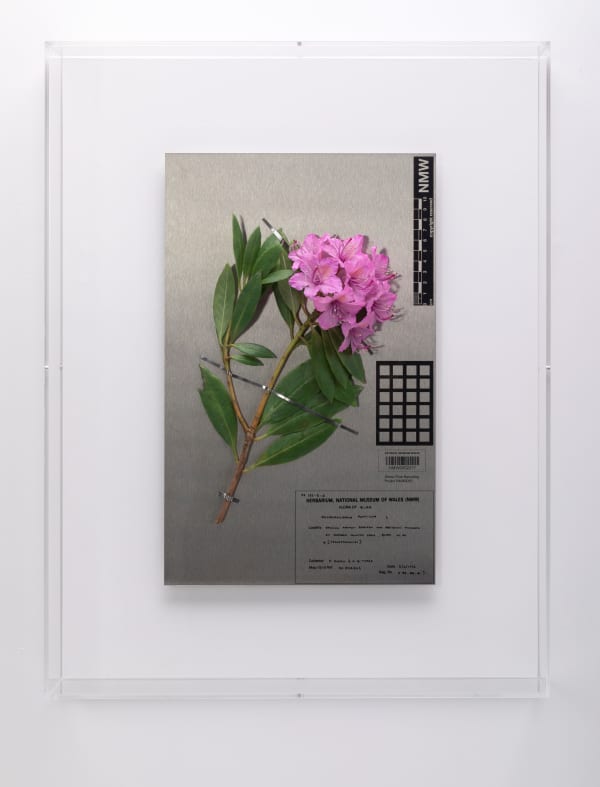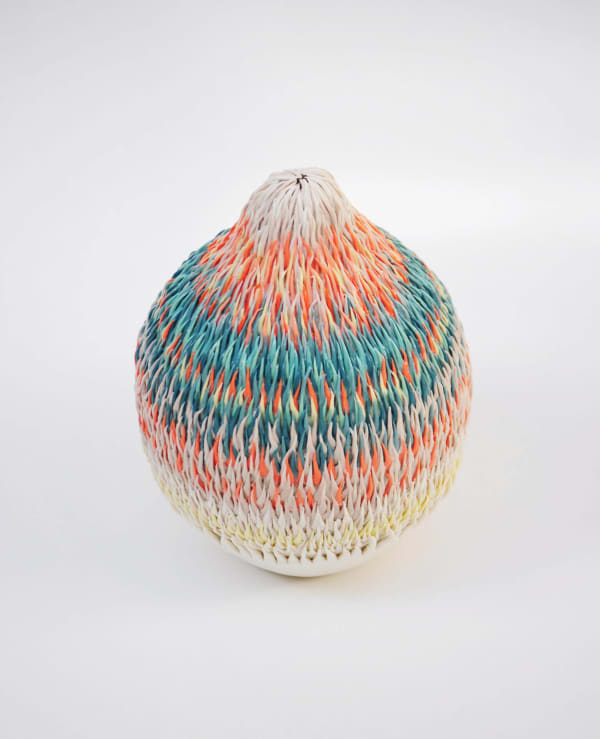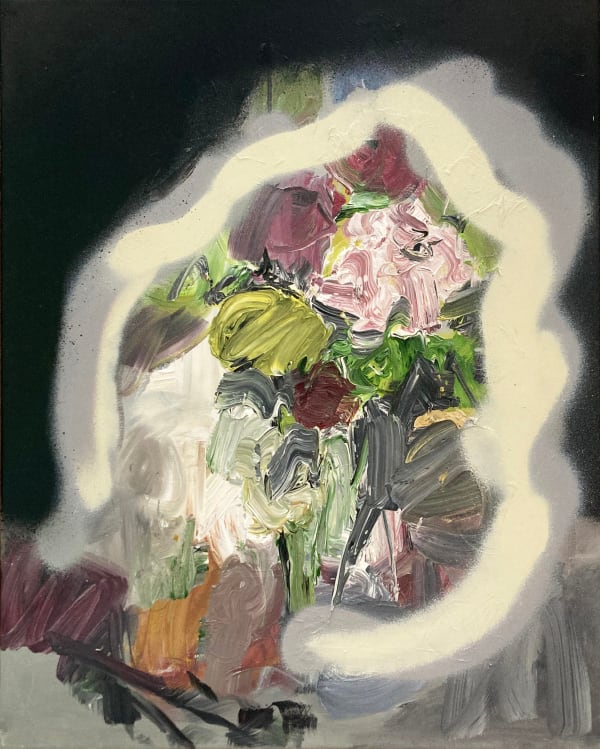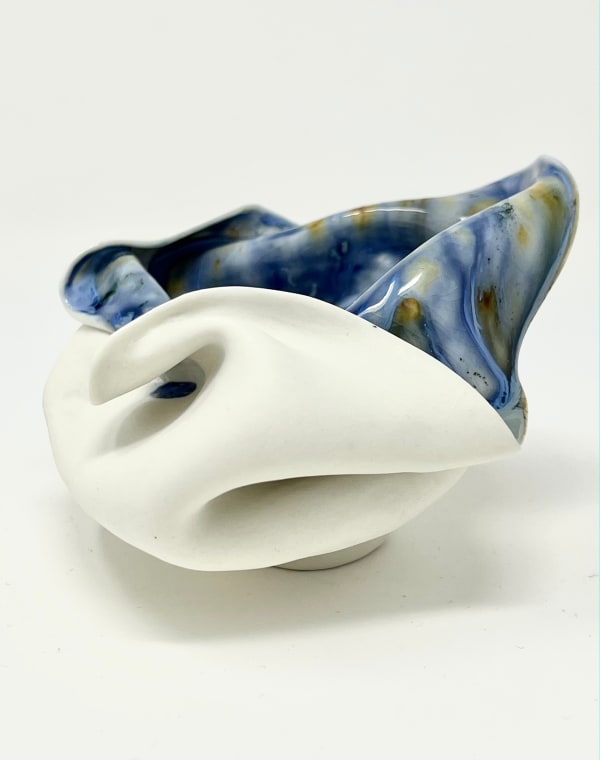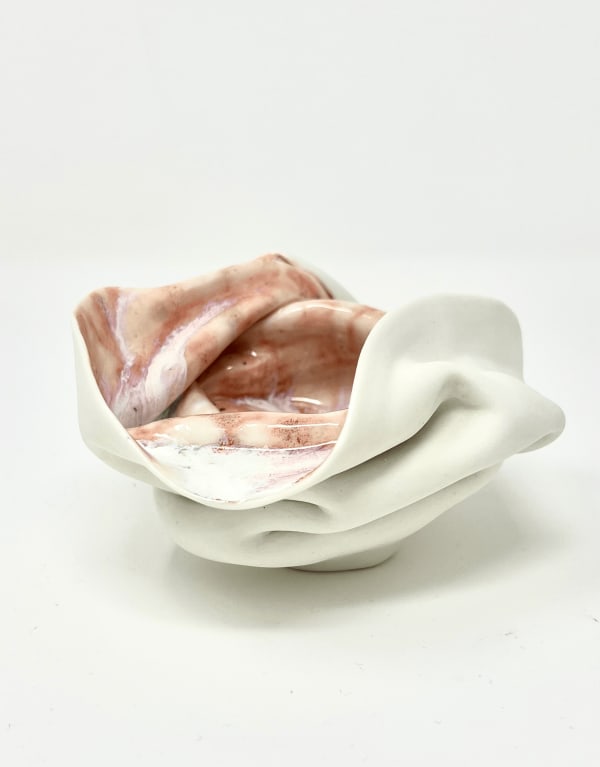-
 Anja WülfingGrecian Lady, 2022Oil, Acrylic, Pencil and Marker on Canvas100 x 100 x 2 cm
Anja WülfingGrecian Lady, 2022Oil, Acrylic, Pencil and Marker on Canvas100 x 100 x 2 cm
39 1/4 x 39 1/4 x 3/4 in.Courtesy of Cynthia Corbett GalleryCopyright The Artist -
 Anja WülfingAtalanta, 2022Oil, Acrylic, Marker on Canvas100 x 100 x 2 cm
Anja WülfingAtalanta, 2022Oil, Acrylic, Marker on Canvas100 x 100 x 2 cm
39 1/4 x 39 1/4 x 3/4 in.Courtesy of Cynthia Corbett GalleryCopyright The Artist -
 Katherine LubarLevels, 2022Acrylic on paper46.3 x 30.9 cm
Katherine LubarLevels, 2022Acrylic on paper46.3 x 30.9 cm
18 1/4 x 12 1/4 in.Courtesy of Cynthia Corbett GalleryCopyright The Artist -
 Andrea TyrimosIdeas don't sleep, 2022oil on steel106 x 106 cm
Andrea TyrimosIdeas don't sleep, 2022oil on steel106 x 106 cm
41 3/4 x 41 3/4 in.Courtesy of Cynthia Corbett GalleryCopyright The Artist -
 Amy RobsonDry the Rain, 2022oil on canvas100 x 120 cm
Amy RobsonDry the Rain, 2022oil on canvas100 x 120 cm
39 1/4 x 47 1/4 in.Courtesy of Cynthia Corbett GalleryCopyright The Artist -
 Dawn LangleySix Centuries, 2021Machine Learning digital images printed on velvet. QR codes connect the viewer to additional material related to the physical works.63 x 46 x 1.5 cm
Dawn LangleySix Centuries, 2021Machine Learning digital images printed on velvet. QR codes connect the viewer to additional material related to the physical works.63 x 46 x 1.5 cm
24 3/4 x 18 x 1/2 in.Courtesy of Cynthia Corbett GalleryCopyright The Artist -
 Molly WuUnder The Frame, May, 2022Silver, White Topaz, Freshwater pearl, pastel pearl24 x 16.5 x 1.2 cm
Molly WuUnder The Frame, May, 2022Silver, White Topaz, Freshwater pearl, pastel pearl24 x 16.5 x 1.2 cm
9 1/2 x 6 1/2 x 1/2 in.Courtesy of Cynthia Corbett GalleryCopyright The Artist -
 Kristin SjaardaHellebore & Broken Quail Egg, 2021Archival Digital photograph. Framed in custom black wood with non-glare art glass.132 x 89 cm
Kristin SjaardaHellebore & Broken Quail Egg, 2021Archival Digital photograph. Framed in custom black wood with non-glare art glass.132 x 89 cm
35 x 52 in.
Edition of 9 out of 10Edition of 10Courtesy of Cynthia Corbett GalleryCopyright The Artist -
 Viet Ha TranBaroque Flowers, 2021Fine art photography50 x 40 cm
Viet Ha TranBaroque Flowers, 2021Fine art photography50 x 40 cm
19 3/4 x 15 3/4 in.
With frame / passepartout:
66 x 56 cmCourtesy of Cynthia Corbett GalleryCopyright The Artist -
 Darren BallSonia, May 2020Made using hand-knitted wool and found fabrics machine embroidered with a domestic sewing machine onto a vintage scarf.70 x 70 cm
Darren BallSonia, May 2020Made using hand-knitted wool and found fabrics machine embroidered with a domestic sewing machine onto a vintage scarf.70 x 70 cm
27 1/2 x 27 1/2 in.Courtesy of Cynthia Corbett GalleryCopyright The Artist -
 Darren BallLeo, January 2020Made using hand-knitted Shetland wool and found fabrics machine embroidered with a domestic sewing machine onto a gentleman’s vintage scarf and embellished with beads and sequins.64 x 59 cm
Darren BallLeo, January 2020Made using hand-knitted Shetland wool and found fabrics machine embroidered with a domestic sewing machine onto a gentleman’s vintage scarf and embellished with beads and sequins.64 x 59 cm
25 1/4 x 23 1/4 in.Courtesy of Cynthia Corbett GalleryCopyright The Artist -
 Darren BallBlonde with the brunette voice, April 2021Made using found fabrics machine embroidered with a domestic sewing machine onto a vintage handkerchief and embellished with beads and sequins.51 x 52 cm
Darren BallBlonde with the brunette voice, April 2021Made using found fabrics machine embroidered with a domestic sewing machine onto a vintage handkerchief and embellished with beads and sequins.51 x 52 cm
20 x 20 1/2 in.Courtesy of Cynthia Corbett GalleryCopyright The Artist -
 Anietie EkanemOn this threshing floor 1/2, 2022UV print on Aluminium50 x 50 cm
Anietie EkanemOn this threshing floor 1/2, 2022UV print on Aluminium50 x 50 cm
19 3/4 x 19 3/4 in.Courtesy of Cynthia Corbett GalleryCopyright The Artist -
 Sarah Mark/ Typing ThreadsAnti-Migraine, 2022Direct dye, Devore, Screen-printing and Quilting191 x 130 cm
Sarah Mark/ Typing ThreadsAnti-Migraine, 2022Direct dye, Devore, Screen-printing and Quilting191 x 130 cm
75 1/4 x 51 1/4 in.Courtesy of Cynthia Corbett GalleryCopyright The Artist -
 Glynis LamondThe Three Wise Men-Take Away This Cup, 2021Charcoal on Fabriano Paper60 x 63 cm
Glynis LamondThe Three Wise Men-Take Away This Cup, 2021Charcoal on Fabriano Paper60 x 63 cm
23 1/2 x 24 3/4 in.
Framed sizing:
75 cm x 75 cmCourtesy of Cynthia Corbett GalleryCopyright The Artist -
 Jasmine Su Juanyan Gardner"Take your Chinese and shove it up your ass, you chinky pig", 2021Three ivory stoneware with tin shiny glaze and cobalt oxideLargest:
Jasmine Su Juanyan Gardner"Take your Chinese and shove it up your ass, you chinky pig", 2021Three ivory stoneware with tin shiny glaze and cobalt oxideLargest:
26 x 26.5 x 6 cm
Medium:
18 x 21 x 5 cm
Small:
16.5 x 11 x 5.5 cmCourtesy of Cynthia Corbett GalleryCopyright The Artist -
 Viktoria KurganskaiaVessel from my project “FRAGILE MATTER“, 2022Wild clay, sand, dolomite from black sea coast, kaolin, oxidation firing27.9 x 22.9 cm
Viktoria KurganskaiaVessel from my project “FRAGILE MATTER“, 2022Wild clay, sand, dolomite from black sea coast, kaolin, oxidation firing27.9 x 22.9 cm
11 x 9 in.Courtesy of Cynthia Corbett GalleryCopyright The Artist -
 Kate BraineSea Green With Red And Orange In Purple Pot No.1, 202222.9 x 40.6 cm
Kate BraineSea Green With Red And Orange In Purple Pot No.1, 202222.9 x 40.6 cm
9 x 16 in.
Bowl width: 9 inchesCourtesy of Cynthia Corbett GalleryCopyright The Artist -
 Kate BraineCrazy Red and Orange Plant No. 2 , 2022Stoneware with porcelain central white flower in Poppy Red, orange with berries in purple bowl.30.5 x 30.5 cm
Kate BraineCrazy Red and Orange Plant No. 2 , 2022Stoneware with porcelain central white flower in Poppy Red, orange with berries in purple bowl.30.5 x 30.5 cm
12 x 12 in.
Width of bowl: 8 in.Courtesy of Cynthia Corbett GalleryCopyright The Artist -
 Kate BraineTwo Eyes Three Toes, Purple Monster No.6, 2022Large Stoneware41.9 x 33 cm
Kate BraineTwo Eyes Three Toes, Purple Monster No.6, 2022Large Stoneware41.9 x 33 cm
16 1/2 x 13 in.Courtesy of Cynthia Corbett GalleryCopyright The Artist -
 SaeRi SeoPopping Good Child, 2022Porcelain, 1220℃, Unglazed24 x 24 x 28 cm
SaeRi SeoPopping Good Child, 2022Porcelain, 1220℃, Unglazed24 x 24 x 28 cm
9 1/2 x 9 1/2 x 11 in.Courtesy of Cynthia Corbett GalleryCopyright The Artist -
 SaeRi SeoCrooked Good Child, 2022Porcelain, 1220℃, Unglazed40 x 15 x 15 cm
SaeRi SeoCrooked Good Child, 2022Porcelain, 1220℃, Unglazed40 x 15 x 15 cm
15 3/4 x 6 x 6 in.Courtesy of Cynthia Corbett GalleryCopyright The Artist -
 Yusun WonOpening up space_inspired by Young Jun, 2022PorcelainOutside:
Yusun WonOpening up space_inspired by Young Jun, 2022PorcelainOutside:
27 x 27 x 26.5 cm
10 3/4 x 10 3/4 x 10 1/2 in.
Inside:
17 x 17 x 28.5 cmCourtesy of Cynthia Corbett GalleryCopyright The Artist -
 Edgar WardTelling, 2022Porcelain20 x 18 x 15 cm
Edgar WardTelling, 2022Porcelain20 x 18 x 15 cm
7 3/4 x 7 x 6 in.Courtesy of Cynthia Corbett GalleryCopyright The Artist -
 Adele HowittHinterwater V, 2022EW Terracotta Clay. Barium & cobalt addition matt glaze, sprayed.40.6 x 25.4 cm
Adele HowittHinterwater V, 2022EW Terracotta Clay. Barium & cobalt addition matt glaze, sprayed.40.6 x 25.4 cm
16 x 10 in.Courtesy of Cynthia Corbett GalleryCopyright The Artist -
 Inger Sif HeeschenOh, That Magic Feeling, 2022Ceramics - Stoneware with gold leaf on rolling pink plinth.85 x 75 x 75 cm
Inger Sif HeeschenOh, That Magic Feeling, 2022Ceramics - Stoneware with gold leaf on rolling pink plinth.85 x 75 x 75 cm
33 1/2 x 29 1/2 x 29 1/2 in.Courtesy of Cynthia Corbett GalleryCopyright The Artist -
 Ashley JanuaryQuinn and Ashley Study, 2020With courtesy of Rudolph/Blume CollectionOil on linen30.5 x 22.9 cm
Ashley JanuaryQuinn and Ashley Study, 2020With courtesy of Rudolph/Blume CollectionOil on linen30.5 x 22.9 cm
12 x 9 in.
With courtesy of Rudolph/Blume CollectionCourtesy of Cynthia Corbett GalleryCopyright The Artist -
 Ashley JanuaryAmber and Sam Study, 2020Oil on linen22.9 x 30.5 cm
Ashley JanuaryAmber and Sam Study, 2020Oil on linen22.9 x 30.5 cm
9 x 12 in.Courtesy of Cynthia Corbett GalleryCopyright The Artist -
 Ashley JanuaryCrystal and Dylan Study, 2020Gouache on gesso board22.9 x 30.5 cm
Ashley JanuaryCrystal and Dylan Study, 2020Gouache on gesso board22.9 x 30.5 cm
9 x 12 in.Courtesy of Cynthia Corbett GalleryCopyright The Artist -
 Michelle HeronScrewed, 2021Acrylic on gesso panel40 x 50 cm
Michelle HeronScrewed, 2021Acrylic on gesso panel40 x 50 cm
15 3/4 x 19 3/4 in.Courtesy of Cynthia Corbett GalleryCopyright The Artist -
 Jemima MurphyDownpour, 2022oil on canvas149.9 x 120 cm
Jemima MurphyDownpour, 2022oil on canvas149.9 x 120 cm
59 x 47 1/4 in.Courtesy of Cynthia Corbett GalleryCopyright The Artist -
 Jemima MurphyBold Reprisal, 2022Oil on Canvas120 x 90 cm
Jemima MurphyBold Reprisal, 2022Oil on Canvas120 x 90 cm
47 1/4 x 35 1/2 in.Courtesy of Cynthia Corbett GalleryCopyright The Artist -
 Jemima MurphyBlue Heart, 2022Oil on Canvas150 x 120 cm
Jemima MurphyBlue Heart, 2022Oil on Canvas150 x 120 cm
59 x 47 1/4 in.Courtesy of Cynthia Corbett GalleryCopyright The Artist -
 Ronan McGeoughSunset Studio, 2020Oil on canvas70 x 100 cm
Ronan McGeoughSunset Studio, 2020Oil on canvas70 x 100 cm
27 1/2 x 39 1/4 in.Courtesy of Cynthia Corbett GalleryCopyright The Artist -
 Elaine Woo MacGregorBathers in Avon, 2022Acrylic on Linen
Elaine Woo MacGregorBathers in Avon, 2022Acrylic on Linen
Framed:
63 x 53 x 3.5 cm
24 3/4 x 20 3/4 x 1 1/2 in.Courtesy The Artist and The Gallery -
 Freya NashEternal Dance (A person, a thing, a shadow), 2022Oil and graphite on canvas140 x 100 cm
Freya NashEternal Dance (A person, a thing, a shadow), 2022Oil and graphite on canvas140 x 100 cm
55 x 39 1/4 in.Courtesy of Cynthia Corbett GalleryCopyright The Artist -
 Olga MorozovaFortifications Of The City, 2022Oil, sackcloth, trench sand70 x 60 cm
Olga MorozovaFortifications Of The City, 2022Oil, sackcloth, trench sand70 x 60 cm
27 1/2 x 23 1/2 in.Courtesy of Cynthia Corbett GalleryCopyright The Artist -
 Ramon Omolaja AdeyemiSelf Portrait, 2022With courtesy of Rudolph/Blume CollectionOil on canvas
Ramon Omolaja AdeyemiSelf Portrait, 2022With courtesy of Rudolph/Blume CollectionOil on canvas
40 x 30 cm
15 3/4 x 11 3/4 in.
With courtesy of Rudolph/Blume CollectionCourtesy of Cynthia Corbett GalleryCopyright The Artist -
 Kate QuinlanTriskele V, 2022Porcelain, glaze.35 x 35 x 11 cm
Kate QuinlanTriskele V, 2022Porcelain, glaze.35 x 35 x 11 cm
13 3/4 x 13 3/4 x 4 1/4 in.Courtesy of Cynthia Corbett GalleryCopyright The Artist -
 Xanthe BurdettThe Two Bathers, 2022Oil on canvas70 x 50 cm
Xanthe BurdettThe Two Bathers, 2022Oil on canvas70 x 50 cm
27 1/2 x 19 3/4 in.Courtesy of Cynthia Corbett GalleryCopyright The Artist -
 Stephannie CartwrightPapalio, 2022Grogged terracotta, porcelain slips, oxides and mason stains38 x 16 cm
Stephannie CartwrightPapalio, 2022Grogged terracotta, porcelain slips, oxides and mason stains38 x 16 cm
15 x 6 1/4 in.Courtesy of Cynthia Corbett GalleryCopyright The Artist -
 Stephannie CartwrightDaisy Makeig-Jones Pot, 2022Coloured porcelain, ceramic shards, oxides and mason stains17 x 11 cm
Stephannie CartwrightDaisy Makeig-Jones Pot, 2022Coloured porcelain, ceramic shards, oxides and mason stains17 x 11 cm
6 3/4 x 4 1/4 in.Courtesy of Cynthia Corbett GalleryCopyright The Artist -
 Camilla HanneyAltered Madonnas, 2020cast and handbuilt porcelain, gold lustreLarge figures:
Camilla HanneyAltered Madonnas, 2020cast and handbuilt porcelain, gold lustreLarge figures:
35 x 7 cm
13 3/4 x 2 3/4 in.
Courtesy of Cynthia Corbett GalleryCopyright The Artist -
 Camilla HanneyAltered Madonnas, 2020cast and handbuilt porcelain, gold lustreSmall figures:
Camilla HanneyAltered Madonnas, 2020cast and handbuilt porcelain, gold lustreSmall figures:
17 x 4 cm
6 3/4 x 1 1/2 in.Courtesy of Cynthia Corbett GalleryCopyright The Artist -
 Jane WardOf the Sea and Land, 2022digital print, paint, ink on canvas70 x 90 cm
Jane WardOf the Sea and Land, 2022digital print, paint, ink on canvas70 x 90 cm
27 1/2 x 35 1/2 in.Courtesy of Cynthia Corbett GalleryCopyright The Artist -
 Jane WardUntitled , 2022digital print, paint, ink on paper22.5 x 30 cm
Jane WardUntitled , 2022digital print, paint, ink on paper22.5 x 30 cm
8 3/4 x 11 3/4 in.Edition of 10Courtesy of Cynthia Corbett GalleryCopyright The Artist -
 Ryan BarrettRTB-1, 2021White Porcelain24 x 20 cm
Ryan BarrettRTB-1, 2021White Porcelain24 x 20 cm
9 1/2 x 7 3/4 in.Courtesy of Cynthia Corbett GalleryCopyright The Artist -
 Ryan BarrettRTB - 2, 2021Porcelain with mixed oxides44 x 28 cm
Ryan BarrettRTB - 2, 2021Porcelain with mixed oxides44 x 28 cm
17 1/4 x 11 in.Courtesy of Cynthia Corbett GalleryCopyright The Artist -
 Ryan BarrettRTB-0211, 2021White Porcelain53 x 20 cm
Ryan BarrettRTB-0211, 2021White Porcelain53 x 20 cm
20 3/4 x 7 3/4 in.Courtesy of Cynthia Corbett GalleryCopyright The Artist -
 Ryan BarrettRTB-112, 2021A mix of Black and White Porcelain.51 x 21 cm
Ryan BarrettRTB-112, 2021A mix of Black and White Porcelain.51 x 21 cm
20 x 8 1/4 in.Courtesy of Cynthia Corbett GalleryCopyright The Artist -
 Margo SelbyCARRE SERIES- Work 5, 2022Handwoven stretched lampas panel, made on a 32 shaft Leclerc Weavebird loom medium: Cotton and silk, stretched and framed in painted wood121.5 x 112.5 x 3.5 cm
Margo SelbyCARRE SERIES- Work 5, 2022Handwoven stretched lampas panel, made on a 32 shaft Leclerc Weavebird loom medium: Cotton and silk, stretched and framed in painted wood121.5 x 112.5 x 3.5 cm
47 3/4 x 44 1/4 x 1 1/2 in.Courtesy of Cynthia Corbett GalleryCopyright The Artist -
 Margo SelbyVEXILLUM STUDY, Work 2, 2021Tencel, cotton and silk72.2 x 65.2 cm
Margo SelbyVEXILLUM STUDY, Work 2, 2021Tencel, cotton and silk72.2 x 65.2 cm
28 1/2 x 25 3/4 in.Courtesy of Cynthia Corbett GalleryCopyright The Artist -
 Rosie EmersonAthena, 2022Cyanotype with 22crt Gold Leaf on Paper113 x 78.7 cm
Rosie EmersonAthena, 2022Cyanotype with 22crt Gold Leaf on Paper113 x 78.7 cm
44 1/2 x 31 in.Unique Original, With one Artist ProofCourtesy of Cynthia Corbett GalleryCopyright The Artist -
 Rosie EmersonHorizon, 2022Cyanotype on Paper60 x 60 cm
Rosie EmersonHorizon, 2022Cyanotype on Paper60 x 60 cm
23 1/2 x 23 1/2 in.
Framed size:
74 cm x 74 cm x 7 cmArtist ProofCourtesy of Cynthia Corbett GalleryCopyright The Artist -
 Alison MulroyRe-entry, 2022Oil on canvas96 x 76 x 3 cm
Alison MulroyRe-entry, 2022Oil on canvas96 x 76 x 3 cm
37 3/4 x 30 x 1 1/4 in.Courtesy of Cynthia Corbett GalleryCopyright The Artist -
 Jason KattenhornLove TRANScends, 2020Fine Art Print, on Matt 200gsm High White conservation digital paper.29.7 x 21 cm
Jason KattenhornLove TRANScends, 2020Fine Art Print, on Matt 200gsm High White conservation digital paper.29.7 x 21 cm
11 3/4 x 8 1/4 in.Edition of 1/20Courtesy of Cynthia Corbett GalleryCopyright The Artist -
 Felix ChesherMorning Tea, 2020Oil on Canvas61 x 46 cm
Felix ChesherMorning Tea, 2020Oil on Canvas61 x 46 cm
24 x 18 in.
Framed size:
65 x 50 cmCourtesy of Cynthia Corbett GalleryCopyright The Artist -
 Annette Marie TownsendAliens 1956, 2021Courtesy of Ruup & FormBeeswax collected from the beehives on the roof of National Museum Cardiff, artists’ beeswax, paraffin wax, tinned copper wire, tissue paper, cotton thread, artists’ pigments, acrylic paint, acrylic varnish. Mounted on a stainless steel plate with stainless steel strips.41.5 x 26 cm
Annette Marie TownsendAliens 1956, 2021Courtesy of Ruup & FormBeeswax collected from the beehives on the roof of National Museum Cardiff, artists’ beeswax, paraffin wax, tinned copper wire, tissue paper, cotton thread, artists’ pigments, acrylic paint, acrylic varnish. Mounted on a stainless steel plate with stainless steel strips.41.5 x 26 cm
16 1/4 x 10 1/4 in.
Framed:
60 x 46 x 12 cmCourtesy of Cynthia Corbett GalleryCopyright The Artist -
 Annette Marie TownsendAliens 1992, 2021Courtesy of Ruup & FormBeeswax collected from the beehives on the roof of National Museum Cardiff, artists’ beeswax, paraffin wax, tinned copper wire, tissue paper, cotton thread, artists’ pigments, acrylic paint, acrylic varnish. Mounted on a stainless steel plate with stainless steel strips.41.5 x 26 cm
Annette Marie TownsendAliens 1992, 2021Courtesy of Ruup & FormBeeswax collected from the beehives on the roof of National Museum Cardiff, artists’ beeswax, paraffin wax, tinned copper wire, tissue paper, cotton thread, artists’ pigments, acrylic paint, acrylic varnish. Mounted on a stainless steel plate with stainless steel strips.41.5 x 26 cm
16 1/4 x 10 1/4 in.
Framed:
60 x 46 x 12 cmCourtesy of Cynthia Corbett GalleryCopyright The Artist -
 Maria Diletta RondoniRainbow Bud, 2022Hand Built Porcelain16 x 24 cm
Maria Diletta RondoniRainbow Bud, 2022Hand Built Porcelain16 x 24 cm
6 1/4 x 9 1/2 in.Courtesy of Cynthia Corbett GalleryCopyright The Artist -
 Maria Diletta RondoniGemma/Red and blue bud, 2022Hand-built porcelain25 x 28 cm
Maria Diletta RondoniGemma/Red and blue bud, 2022Hand-built porcelain25 x 28 cm
9 3/4 x 11 in.Courtesy of Cynthia Corbett GalleryCopyright The Artist -
 Miranda BoultonInto the Groove, 2021Oil and acrylic spray paint on canvas78 x 63 x 2 cm
Miranda BoultonInto the Groove, 2021Oil and acrylic spray paint on canvas78 x 63 x 2 cm
30 3/4 x 24 3/4 x 3/4 in.Courtesy of Cynthia Corbett GalleryCopyright The Artist -
 Miranda BoultonThe World is Ours I, 2021Oil and acrylic spray paint on canvas52 x 42 x 2 cm
Miranda BoultonThe World is Ours I, 2021Oil and acrylic spray paint on canvas52 x 42 x 2 cm
20 1/2 x 16 1/2 x 3/4 in.Courtesy of Cynthia Corbett GalleryCopyright The Artist -
 Miranda Boulton18th Century Girl, 2022Oil and acrylic spray paint on canvas60 x 50 cm
Miranda Boulton18th Century Girl, 2022Oil and acrylic spray paint on canvas60 x 50 cm
23 1/2 x 19 3/4 in.Courtesy of Cynthia Corbett GalleryCopyright The Artist -
 Zoe WeisselbergImaginarium Collapsed 1, 2021/22Paper porcelain, glazeheight 13 cm
Zoe WeisselbergImaginarium Collapsed 1, 2021/22Paper porcelain, glazeheight 13 cm
height 5 in.Courtesy of Cynthia Corbett GalleryCopyright The Artist -
 Zoe WeisselbergImaginarium Collapsed 2, 2021/22Paper porcelain, glazeheight 9 cm
Zoe WeisselbergImaginarium Collapsed 2, 2021/22Paper porcelain, glazeheight 9 cm
height 3 1/2 in.Courtesy of Cynthia Corbett GalleryCopyright The Artist -
 Zoe WeisselbergImaginarium, Collapsed 3, 2021/22Paper porcelain, glazeheight 7 cm
Zoe WeisselbergImaginarium, Collapsed 3, 2021/22Paper porcelain, glazeheight 7 cm
height 2 3/4 in.Courtesy of Cynthia Corbett GalleryCopyright The Artist -
 Eve de HaanBe Nice, 2021Red neon, perspex20 x 70 cm
Eve de HaanBe Nice, 2021Red neon, perspex20 x 70 cm
7 3/4 x 27 1/2 in.Unique pieceCourtesy of Cynthia Corbett GalleryCopyright The Artist
SaeRi Seo
SaeRi Seo (born 1992, Korea) studied a BA in ceramics from Seoul Women's University and completed an MA at Cardiff Metropolitan University. Seo has partaken in a number of exhibitions, including ‘태’ (2015) group exhibition at Korea Crafts & Design Foundation Gallery; ‘Sound of Permeate (2021) group exhibition; and ‘아우르다’ (2021) group exhibition. In 2015, she won a prize in The 12th Ceramic Arts Award of Korea and in 2022 she was the finalist of the BADA Art Prize.
Seo commonly works with porcelain and the throwing technique. Her forms are influenced by traditional Korean pottery, specifically the Moon jar. The Moon jars were the representative Korean traditional pottery of the Jose Dynasty. They have contributed to elevating the reputation of Korean ceramics worldwide. However, during this time, Moon jars were only created by men. Women were not permitted to create them for fear they would bring bad luck.
This fear of bad luck leaked into Seo’s upbringing, with her father preferring sons over his three daughters. Growing up, Seo was compelled to be kind and polite to compensate for this. She therefore turned to pottery to express her trauma. Employing the traditional Moon jar style, she creates forms to reveal her feelings of oppression caused by her cultural and social backgrounds. In the process of destroying, the flowers bloom and show both fragility and intensity.
Yusun Won
Yusun Won (born 1992, South Korea) studied ceramics at Kookmin University in Seoul, South Korea, completing her BFA and MFA in ceramics with distinction. She then completed her Masters in ceramics with distinction at Cardiff Metropolitan University. Won had her first solo exhibition at KCDF Gallery, sponsored by Korea Craft Design Foundation. She has had multiple exhibitions across South Korea and the UK and her work has also been exhibited in the Craft Trend Fair, Seoul Design Art Fair, and Art In Clay.
Won was the winner of CICC 2019 Craft at Cheong Ju International Craft Competition and the finalist of 2021 BADA Art Award. She is the recipient of Franz Rising Star Scholarship. She has also collaborated with illustrators, designers, musicians and writers, which resulted in collaborative projects which were displayed in galleries or published in the Journal of the Korean Society of Ceramic Art.
Won’s art practice was restricted by Covid. Within the confines of her room, a Jose Dynasty Bottle caught her eye. She developed works based on the impressions of the bottle. For her, vessels symbolise everyday life and by exploring vessels from various angles she is able to cross boundaries between the daily object and an art object.
Edgar Ward
Edgar Ward (born 1995, Australia) studied at the City and Guilds of London Art School, completing an Art Foundation and subsequently studied stone carving for three years. He has participated in a number of exhibitions, including ‘Thrown Contemporary at 51 Southwark Street’ (2021) at London Bridge; ‘3D Clay Printing’ (2021) at London Design Festival, Brompton Design District; and ‘The Power of Material: From Virtual to Physical’ (2021), at the Design Museum. He has won a number of awards such as, the Art Feature at Crafts Magazine in 2021 and The Charlotte Fraser Prize in 2021.
Growing up in Islamabad, New Delhi and Paris, Ward developed a deep interest in the art and architecture that surrounded him. This fascination with his surroundings in the urban environment and the visual merging of history, nature and contemporary lives and cultures remains key to his interests and informs his work.
Ward’s current work seeks to animate material to express fragmented stories. Using a process of working from observation, memory and intuition, he builds and combines evocative forms and textures that often reference art history. The work moves between figuration and abstraction, with defined elements set within expressive and emotive environments that enclose or hold the subject. He is interested in working between disciplines and expanding the potential of established art forms, through finding new approaches to working in three dimensions and incorporating digital modelling and 3D printing technologies within historic processes and materials.
Michelle Heron
Michelle Heron (born 1980, Norfolk) studied Fine Art at the University of Hertfordshire. She has participated in a number of exhibitions including Young Masters Art Prize (2022) at Exhibitionist Hotel, London; Townhouse Open (2022) in Spitafields, London; Tarpey Gallery Open (2022) in Castle Donington; and The Other Art Fair (2022), London. Heron has been shortlisted for a prizes, such as the Jackson’s Painting Prize in 2020 and the Contemporary Painting Prize in 2019.
Heron uses paint as a tool to study the overlooked and the ordinary. Her work is concerned with the spaces that are unused or forgotten, the traces where people have been and the pockets of life that we ignore. To her they evoke an air of mystery or foreboding. Wether it is the changing use of buildings, faded shop signs, graffiti on overlooked street furniture, or places on the verge of being lost, they are all places that she wants to record before being cleaned away.
Heron believes that it is important to record our vanishing cultural heritage. They are reminders of the past but also survivors struggling to find a place in the modern world. We couldn't have imagined 10 or 20 years ago that laundrettes, pubs and small shops could disappear. What will hold communities together in the future? These were places that brought people together. We can't imagine what our high streets will become in the future now.
Jemima Murphy
Jemima Murphy (born 1992, London) studied BA Hons in Russian Language at the University of Bristol (2010-2014) and is currently completing the MA Fine Art at City & Guild’s of London Art School (2022-2023). Her artworks explore emotional memory and affectivity through reimagined landscapes and places she has been. She examines past experiences, relationships, and how love, loss, fears, desires and regrets are constantly reevaluated and reinterpreted. Her paintings occupy the liminal space between reality, memory and desire. Murphy’s paintings leave space for the viewer’s own interpretation, eliciting an array of emotions dependent on the viewer’s emotional state.
Inspired by the Fauves, Murphy’s work embodies a Neo-Fauvist and expressionist style to create her immersive landscapes and foliage. By painting ambiguous locations, Murphy hopes to impart a feeling though her colourful dreamscapes. Very often the works are zoomed in to capture the fleeting and ephemeral nature of a memory - almost like flashes or corner fragments of a moment. Murphy is fascinated in how memories can be idolised until they become the epitome of fantasy and desire.
Ronan McGeough
Ronan McGeough’s studied at Limerick School of Art and Design in 2011. The following year he worked as a professional artist as part of two of Limerick studio collectives, before moving to London in 2012. He has since exhibited internationally in Paris, Berlin, Vienna amongst numerous times in the U.S.A.
McGeough aims to question the curious fast paced world transformed through rich gestural paintings. He wants to lead the audience on a journey across multiple views of narrative scenes, combining action painting with objective subject matter. His scenes comment on the socio-political issues of today. For him, the best art reflects the current cultural climate it’s in.
McGeough explores urban influenced forms of expressionism, constructing landscapes with an embedded connection between street art and contemporary art disciplines. In his work he tries to convey a deeply rooted spirituality which he strove to make more prominent by exploring the unknown, bringing to the onlookers attention the things that may have been overlooked whilst reminding the viewer that within our own struggle resides beauty. In every piece he creates, he employs the traditional compositional elements and attempts to combine these with a more contemporary painting technique. As such, his work is a constant celebration of traditional styles and approaches which he believes can be lost in today’s contemporary artistic approaches.
Elaine Woo MacGregor
Elaine Woo MacGregor (born 1981, Edinburgh), a born Chinese artist, studied Fine Art at the Glasgow School of Art. She now lives in Linlithgow, West Lothian, and works in Glasgow and Edinburgh. She has exhibited in galleries in Edinburgh, Glasgow, London, Cambridge and abroad. Her work, ‘Hotel No.4' is housed in the public galleries collection, The Atkinson Art Gallery, Southport. Woo MacGregor was an Artist in Residence in Amhuinnsuidhe Castle Estate, Isle of Harris in 2010, Vermont Studio Center, U.S.A in 2009 and Guizhou Art Academy, China in 2008.
She has been teaching at the Glasgow School of Art since 2008 and the Centre for Lifelong Learning at Strathclyde University since 2009, as an art lecturer. In 2019 she founded Linlithgow Art School, specialising in drawing and painting classes for both children and adults.
Woo MacGregor’s work encapsulates the world seen through the eyes of a cross cultural artist. She uses eclectic mark making and imagery to create atmospheric and theatrical scenes. Although her painted stories are often fictitious, elements of the picture are based on real people, places and things. Her work has been shown in the U.K, U.S.A, Australia and Thailand.
Freya Nash
Freya Nash (born 1995, London) studied at Central Saint Martins. Her work explores the incomprehensible meaning of life by attempting to pin down that which is felt and lived, into something tangible. She creates a world, both the real and surreal, where myth converges with the biological and psychological, and the everyday meets the extraordinary. This union of fantasy and reality reflects the unique experience of being human. As the worlds we create, and dreams that linger in our subconscious, help us to make sense of the lived experience, or to escape from it. It is the archetypes and symbols from the unconscious that have lead to stories, images and ideas shared universally, and it is this shared subconscious which connects all humans.
Her process involves both the primal gestures of her hands and the precision of the brush and needle. Text is also included, sitting somewhere between poetry and pros. Carnal energy and impulse meet thoughtful detail. This dynamic balance of opposites within the work is used to convey the tension created when marking boundaries of intimacy and revelation. As interior worlds of the body and mind are held in union with the external to create a space that is both known and unknown - blending the boundaries of the private and public, the concealed and revealed.
There is no sense of right or wrong, no hierarchy as the chaos and refinery paradoxically conflict and compliment, mirroring the absurd complexity of life. Representing that which borders the conscious and unconscious, absence and presence; the oscillation of the soul. It all comes together to reflect the wholeness of being, the many parts that come together to form our reality.
Olga Morozova
Olga Morozova (born 1972, Kyiv, Ukraine) received a master's degree in painting from the National Academy of Arts and Architecture in 1998. She has participated in more than twenty solo exhibitions and over one hundred group exhibitions and international projects. In 2019, Morozova represented Ukraine in Dubai at the exhibition ‘Women Artists from 100 Countries’; in 2022 she took part in the exhibition of Ukrainian artists as part of the Venice Biennale; and in December 2022 she will represent Ukraine at the Asian Art Bienniale in Bangladesh.
Morozova consciously chose the Fauvist palette, adopting the strong colours and fierce brushwork style. Working intuitively, Morozova boldly layers colours to create eye-catching compositions. The powerful temperament of an outwardly fragile woman is embodied in the graphic focus on the motif, in expressive and improvisational writing, in ornamental and decorative solutions. In her works, there is a sensual Dionysianism, which is wonderfully combined with her manner of painting. Morozova’s paintings are impressive, like stained glass windows, and create a luminous aura around them.
Olga Morozova will be collaborating in November 2022 with artist and jeweller Phoebe Walsh on the exhibition Flowers From The Front Line. Flowers From The Frontline Series will be on show at the Archivist exhibit, in the Garden Museum, from November 12th to December 22nd 2022. After touring, the series will be auctioned individually to raise money for Artists in Ukraine: https://gardenmuseum.org.uk/ In addition, filmmaker Carmela Corbett is currently working on a feature length documentary entitled Flowers From The Frontline, which will explore the artist’s life and the power of art created during war.
Ramon Omolaja Adeyemi
Ramon Omolaja Adeyemi (born 1978, Lagos) studied the Higher National Diploma (HND) in Fine and Applied Art. He then joined the National Gallery of Art in Nigeria, becoming the Principle Technical Officer.
Yam Seller (2022) is an oil painting portrayed to promote the value and contribution of yams to economic growth and development. From cultivation, to harvesting and marketing, yam have a great economic value. However, this painting only aims at the marketing of yam which has to do with its promotion both locally and internationally. It aims at drawing people's attention to hidden prosperity in yam business by facilitating intellectual curiosity on how to generate income doing yam business.
In Nigeria, yam business is a profitable food business. Yams also signify cultural importance in some areas which go beyond their dietary importance. A bountiful harvest of the crop by a farmer shows his wealth, skill, and economic power. It is hoped that identifying with this painting will increase interest in the promotion of yams not just as a staple, but rather as a tool to improve our economy.
Kate Quinlan
Kate Quinlan (born 1989, Ireland) studied Ceramics at the National College of Art and Design, Dublin in 2013, before completing an MA in Material and Visual Culture at University College London (2019). She combines this with eight years curatorial and project management experience at the Victoria and Albert Museum. Quinlan recently won the Blue Egg Gallery Bursary in 2022, and previously a Crafts Council of Ireland Award in 2013. Recent exhibitions have included the 192nd RHA Annual Exhibition 2022, Society of Scottish Artists 123rd Annual Exhibition, Edinburgh in 2021, and Sculpture in Context, Dublin (2021).
Quinlan explores her place in the world through her subliminal experience. Paying attention to the intersubjectivities that emerge within a defined location, she highlights the unspoken value of liminal space and her phenomenological engagement within it. Born and raised in Ireland, Quinlan's work incorporates elements of Irish heritage, mythology and landscape, amalgamated with her lived experience in a colonial English landscape and professional experience at the Victoria and Albert Museum. By re-representing and celebrating ideas of Irish femininity - both the heroic and the mundane - and the overt beauty of these underrepresented accounts, Quinlan carves out a path for less heard voices in our inherently flawed history.
Xanthe Burdett
Xanthe Burdett (born 1995, Devon) is a figurative painter whose work layers portraits and overlapping organic forms. Particular to Burdett’s work is the use of shadows to capture impressions of the natural world - working from life, she paints the shadows beneath plants, often working over several days to create layered effects. The portraits are then drawn out from these chance encounters between sunlight, shadow and paint.
Occasionally lifting figures straight out of historical works, Xanthe Burdett’s finely rendered oil paintings combine classical subjects with vivid colour and layers of natural forms, existing in conversation with those Old Masters who painted the female nude. Layers of transparent paint build a network of tangled plants. Figures emerge from the thicket to join a long line of nude depictions of the feminine body in art. Modern interpretations of classical subjects, they occupy an uneasy space - beyond titillation but vulnerable in their nakedness. They are wary of our gaze.
Stephannie Cartwright
Stephannie Cartwright studied at the the Royal College of Art in the late 90’s. The duality between our perceived lives and the 'unlived' life is what underpins Cartwright’s work. With an early interest in the hedonism of rave culture, escapism has been a common thread, and the need to escape from the domesticity and duty of both mother and wife in more recent years has found her yearning for the 'wild woman' who she now accesses through these making processes. Enabling to lay unconscious of archetypes, symbols, and motifs, to reveal themselves through the surfaces and structures that unfold.
Cartwright’s process and approach is entirely symbiotic to the storytelling - allowing previous knowledge and skills, ideas held, and feelings forgotten to be destroyed and reassembled into new and authentic forms. The spontaneity of the porcelain sculptures are created firstly by destruction. Discarded china, or previously made ceramic pieces are crushed and broken into fragments where the shards are then trapped in thickened daubs of porcelain layers and pigments, creating miniature plinth-like fantasy landscapes.
In contrast, the hand-coiled terracotta vessels take time and the repetition of process to build; allowing for the form to evolve. The approach to surface is underpinned by her painting practice alongside drawing on the rich traditions of surface decoration rooted in the likes of Wedgwood's 'Fairyland Lustreware' of the early 1900's. Layers of porcelain colours and dripping pigments are applied and the technique is repeated then peeled back and added to until hints of imagined fantasy landscapes appear on the surface.
Camilla Hanney
Camilla Hanney (born 1992, Ireland) studied at Goldsmiths University, completing her Masters of Fine Art (2017-2019) and Dun Laoghaire Institute of Art, studying Design and Technology (Visual Arts Practice 2010-2015). She is an Irish artist, living and working in London. Since moving to London, her work has been exhibited by a diverse range of galleries including the South London Gallery in conjunction with Bloomberg New Contemporaries, No. 20 Arts, Muse Gallery, Dora House and The Rosenfeld Gallery and Cromwell Place Gallery.
Hanney has won numerous accolades, including but not limited to, the 2019/20 recipient of the Sarabande foundation studio bursary; the UK Young artist of the year runner-up award; the Committee's Choice prize at ‘Exceptional’, an exhibition of recent graduate work at Collyer Bristow Gallery; the Sculpture Stories Prize; and the Glass Lab award in 2021, providing her with a three month residency and continuous technical support at the Cotswolds Glass foundry. Her work has been featured in articles by Crafts Magazine, Elephant Magazine, Wallpapermag, Showstudio, Mission Mag and Harpers Bazaar.
Working through ceramics, sculpture and installation, Hanney’s practice explores themes of time, sexuality, cultural identity and the corporeal, often referencing the body in both humorous and challenging ways. By subverting traditional, genteel crafts she attempts to transgress and contemplate conventional modes of femininity, deconstructing archaic identities and rebuilding new figures from detritus of the past. By materialising the familiar in an unfamiliar context her work stimulates our ability to rethink our relationship towards objects, threatening the natural order and toying with the tensions that lie between beauty and repulsion, curiosity and discomfort, desire and disgust.
Jane Ward
Jane Ward (born 1960, UK) studied MA Printmaking at The Royal Academy of Art. Her work has appeared in exhibition including, ‘Utopia’ in New York; ‘Saudade’ (2015) in London; ‘Printing New Worlds’ (2014) in Italy; 'Up a Hill Backwards’ and ‘At The Edges’ (2013) at Angus Hughes Gallery, London; ‘Images of the City’ (2012) in Printroom, London; at Christie’s Multiplied (2015); and London Art Fair (2015).
Recent residencies include, CPS 2014) in Lisbon, Portugal; Galeria dos Prazeres (2014) in Madeira; Pedra Sina Residency (2013) in Funchal, Madeira; No.72 John St. Kilkenny (2012) in Ireland. Ward’s work has also featured in Artfutures (2002), Celeste Art Prize (2007), Bloomberg New Contemporaries (2008) and she has been awarded the Terrence Conran Foundation Award and the Tim Mara Prize.
Ward works in digital prints. Her method involves taking lots of photographs of places and layering them on her laptop, alongside photographs of her paintings. By layering and fragmenting the image, she creates a digital collage. She then prints the, on various substrates. These have included paper, canvas, paper mounted behind acetate and aluminium. Once printed, she often works over the printed surface by hand with various pigments and implements.
Ryan Barrett
Ryan Barrett (born 1986, Suffolk) studied at Goldsmiths University, where he experimented in a variety of mediums from sculpture to paintings, and was especially drawn into the world of textile design. Upon moving to New York in 2011 as his modelling career took off; Ryan worked as a print designer. His entrepreneurial spirit led him to co-found his own print and textile studio, and innovative online selling platform, Vooprint Ltd, in the beginning of 2013.
Barrett first began experimenting with ceramic in 2013, taking over his grandmother’s shed to settle into his first pottery studio. Self-taught, his approach to ceramic is very intuitive and experimental. Antique manmade constructions and sculptural art are the foundation to Barrett’s creative inspiration. He is especially influenced by Modern and Mid-Century abstract art, specifically by the visual language of shapes and monumental forms of British artists Henry Moore and Barbara Hepworth.
From his textile background, Barrett is naturally drawn to surfaces and textures. He constantly experiments with natural glazes and minerals to create tonal mixes and cascading effects. An ever evolving process, much of his work is developed in series and explores variations of forms with soaring organic surface textures.
Margo Selby
Margo Selby (born 1977, Eastbourne) studied at Chelsea College of Art & Design and the Royal College of Art in London, with a term at Atelier National d’Art in Paris. She now teaches in various institutions, and has own studio weaving workshops. In 2020, Margo was the recipient of the Craft Council’s Collect Open Award for her large scale textiles installation Vexillum at Somerset House, and, in 2021, the bi-annual Turner Medal for ‘Britain’s Greatest Colourist’. She also gave the Turner Lecture, reflecting on her practice.
Selby is an artist and designer working with colour and geometric form in textiles. She makes handwoven artworks, and oversees the design work of the Margo Selby Studio for mill production and commercial textiles applications – her tenet being ‘Art Into Industry’ – an approach to making art that is akin to that of the ‘Old Masters’ and mistresses, with their expanded studios and public commissions.
Selby uses thread to create abstract geometric artworks that explore repetition and transition, symmetry and asymmetry, the dynamic and the stable. She is interested in the relationship between the body and the machine, hand and industry, craft and technology. The loom, and the disciplined nature of weaving as a practice, provides boundaries and constraints which can be tested. The orderly nature of the craft of weaving is reflected in the developing designs of the artworks. She is satisfied by rhythmic and uniform repetition – where each element of a composition is changed in a methodical progression.
Rosie Emerson
Rose Emerson (born 1981, Dorset) is an award winning contemporary artist. Having studied and lived in London for ten years, she is now based West Sussex. Emerson’s work is collected and exhibited both in the UK and internationally. She was awarded the Bridgeman Studio Award; participated in the Young Masters Art Prize; exhibited her work in Sphinx Gallery, London; and created a new world record for the largest Cyanotype photograph.
Emerson has undertaken a number of private and commercial commissions, working with brands including Harvey Nichols, The Ivy Club, Sony, Triumph Underwear, Redbull, P&O Cruises, and Annoushka jewellery. Her artwork has also been featured in Vogue, Harpers Bazaar, Another Magazine, The Financial Times Magazine and The Sunday Times Style Magazine.
Emerson creates unapologetically feminine works on paper, which embrace aesthetics and engenders wonder. Her subjects reference historical and contemporary archetypes, such as Artemis and today’s super model. Influenced by the drama of the Baroque and the ethereal qualities of the Pre Raphaelites, she employs lighting, costumes and prop making, as well as printmaking and painting, to create her otherworldly one-off pieces.
Alison Mulroy
Alison Mulroy (born 1978, UK) studied illustration at the University of Westminster. She has since participated in a number of exhibitions, including but not limited to, The Royal Society of British Artists (2020); The Different Gallery (2019), in London; the Mall Galleries SWA show; and Invited onto the committee of the Society of Women Artists in 2007.
Mulroy finds light to be an avenue for expression in the majority of her works. To her, the moods that can be created through various lighting can encapsulate a subject matter’s state of mind and emotion. In each piece she focuses on trying to communicate, and more importantly celebrate, something of the essence of what she is painting.
When painting people, she aims to acknowledge the more subtle, intimate qualities of a sitter as she finds these to be the most authentic, beautiful parts. Strength in vulnerability is the theme that continually engages her. She finds the vital elements of hope and humanity at work in this tension deeply.
Jason Kattenhorn
Jason Kattenhorn studied at Staffordshire University. Kattenhorn is a freelance queer illustrator. He created Sassify Zine in 2016, an award winning queer culture print magazine and online features website that luxuriates in queer art and sassiness.
His illustrations are concerned with the LGBTQ+ bodies we are told to hide. Kattenhorn enjoys exploring queer intimacy in all its forms, celebrating their beauty and resilience.
Felix Chesher
Felix Chesher (born 1997, Reading) studied at The Royal Academy of Dramatic Arts in 2019. Having explored his passion for drawing people and painting portraiture as a young adult, it was the consequences of the COVID pandemic that gave Felix the time to refine his talent for oil painting and portraiture. Whilst his life was paused, Felix was able to reflect and made the conscious decision that he would focus on fulfilling his dream to become a portrait artist.
Throughout his early career, his works have already been exhibited as part of a number of competitions, including having been shortlisted for the BP Portrait Awards (National Portrait Gallery) and being exhibited in the ING Discerning Eye Exhibition at the Mall Galleries. This has led to Felix becoming an in-demand portraitist, regularly undertaking new private commissions. Today, his works are held in private collections across the U.K. and North America. The artist lives and works in London.
Chesher’s work focusses on the male form with homoerotic elements. He is best known for his provocative contemporary realist portraits of the male form. He has painted and worked with iconic and celebrated figures from the LGBTQ+ community, the focus of which formed his first solo exhibition in late 2021 which Felix described as "a positive to come from the horror of the COVID period and an opportunity to celebrate the wider LGBTQ+ community.”
Annette Marie Townsend
Annette Marie Townsend (born 1973, Cardiff) studied Design. She is an interdisciplinary natural history artist, recognised for her skill in wax botanical sculpting, using historic materials and techniques learnt over a 20 year career in a museum environment.
Her scientific drawings and sculptures are held in the collections of Amgueddfa Cymru, in the National Museum Wales, and many of her models are on permanent display in the public galleries at the National Museum Cardiff and Big Pit National Coal Museum. She has produced commissioned work for many UK institutions including the National Botanic Garden of Wales, The Royal Botanic Gardens Kew, Manchester Museum, English Heritage and the BBC. Annette was one of the contemporary craft artists selected by the Crafts Council to exhibit at ‘Collect Open’ 2020, Somerset House, London.
Her work lies at the intersection of art and science. It is an exploration of our relationship with nature from an urban perspective, focusing on the desire to collect, organise, study and ultimately protect the natural world. Townsend merges the nineteenth century tradition of using beeswax to create lifelike representations of biological forms with modern innovation. Employing natural beeswax and man-made paraffin waxes, she raises awareness of current environmental issues.
Maria Diletta Rondini
Maria Diletta Rondoni (born 1984, Italy) studied at the Academy of Fine Arts in Perugia. Maria has partaken in a number of exhibitions including, Flora Danica, Apple House-Guldagergaard International Ceramic Research Center in Skaelskor, Denmark (2021); Matres, International Festival of Ceramics for Women, Ceramics Museum of Deruta, in Perugia (2019); and XI International Exhibition for Ceramic Artists, Third Prize Winner, Museo Muda in Albissola Marina, Savona (2018).
For Rondoni) ceramic works come to life through an anaphoric process of composing different forms that absorbs her in a slow creative flow. She uses few tools, sometimes just the tip of her fingers with a pinch and coil technique. She favours natural clays and loves to create her own palette of pigmented clays, thinking of her work as three-dimensional painting.
Rondoni is inspired by the metamorphosis and permutation of nature, its movements and stages, its strength and fragility, to give voice to its sensual power as the origin of life. Her aim is to create a sort of imaginary, fantastic and corporeal herbarium.
Miranda Boulton
Miranda Boulton (born 1973, Cambridge) is a Contemporary British Painter, living and working in Cambridge, UK. She studied Art History at Sheffield Hallam University, graduating in 1994 and completed three years postgraduate study with Turps Banana Art School, London in 2015.
Boulton has exhibited throughout the UK, recently winning the Jackson’s Painting Prize in 2021. Other exhibitions include: Beating Time (2020) at ARB, Cambridge University; Double Time (2019) at Arthouse1, London; Royal Academy Summer Exhibition in 2019/ 2016; and the Creekside Open in 2019.
Boulton’s paintings are Nature Morte of flora. Her work is a response to historical references within this genre, reimagined into a contemporary pictorial language. Painting from memory and spontaneity, she combines both conscious and unconscious responses, oscillating between control and abandon, spontaneity and intent. Her paintings are an ongoing conversation between the past and the present, where the flowers symbolise the transience of life and each brushstroke capture moments in time.
Adele Howitt
Adele Howitt has exhibited across Europe including, the Steninge Slott Cultural Centre in Sweden for the World Art in Clay, VI Biennal de Ceràmica del Vendrell, Barcelona, Spain, Ceramica Multiplex at Kerameikon, Croatia, Edge at The Gallery Cork Street, RHS Chelsea Flower Show London, various RHS Gardens across Surrey.
Notions of the living landscape, abstraction, pollen grains, and natural pattern mark Howitt’s ceramic art. Slab work is twisted and turned to add detailed relief utilising the traditional pottery techniques discovered whilst investigating the South Yorkshire Potteries. The clay is a sculptural medium, opposing the tradition of using it as a technical medium or an exploration of the vessel. Techniques include, drawing, hand building, coil / slab building, hand-thrown elements, extruded clay, and glazing.
Post-industrial and semi-rural landscapes are her inspiration. Recently the canal, which links the Rivers Humber, the Ouse and the Don, which facilitated the development of the South Yorkshire pottery industry in the eighteenth century. This man-made network of waterways allowed barges to carry works from famous potteries such as Rockingham, Kilnhurst and Mexborough to the ports of Goole and Hull to export around the world. A particular inspiration is the recent emergence of new wildflower and grass habitats along the route as nature reclaims what was lost during industrialisation. Howitt finds this particularly poignant and inspiring. The melancholy feel of the canal's faded industrial history, like so many post-industrial environments, is now being brightened by an explosion of natural wildlife. Her work aims to capture both the industrial past and allude to the contemporary globalisation which has led to its next environmental phase.
The irony is not lost on that the pottery carried on this very waterway in the eighteenth and nineteenth centuries canals displayed idealised Neo-Classical landscapes of the sort that never existed and were vastly removed from the industrial pollution that set in train a process that today has turned full circle. Howitt’s collection celebrates today’s wild and living landscape and heightens awareness of the importance of necessary pollinators, and the dangers of global pollution and environmental change. It commemorates the living landscape at a critical change for the environment.
Inger Sif Heeschen
Inger Sif Heeschen (born 1989, Denmark) graduated from Gerrit Rietveld Academy (2016). Through an interdisciplinary practice, Heeschen’s artistic research explores notions of origin and progress through a translation of cultural objects and artifacts. Heeschen grew up on the Danish Island of Bornholm in the Baltic Sea, where a scenery of burial hills still enthrones the horizon. Witnessing several archaeological digs for traces of a former iron age settlement started an early interest in history told through objects.
Like archaeologists deciphering a vase from just a few fragments, Heeschen practices a particular form of reverse approximation by defining my own potsherds, from where she creates new connections and narratives. Her desire is to sample and merge opposites, with a great interest in traces perceived through process – ideas of the mould, the iteration, the copy and the print.
She aims to contextualise her work within and beyond traditional formats of display and in the context of an interdisciplinary network of artists. Facilitating and curating exhibitions and events is an essential part of her practice. Getting familiar with a specific place can almost be akin to learning etiquette. By approaching iconic imagery, the arcane and archaic, Heeschen main aim - with a subtle sense of anarchism - is to create objects that meander across time.
Jasmine Su Juanyan Gardner
Jasmine Su Juanyan Gardner (born 1997, Suzhou, China) is a Manchester based artist who graduated from Fine Art and Art History and is currently studying a theory-based MA in Research at Manchester School of Art. Gardener has exhibited in a number of exhibitions, including Short Supply (2021) in Manchester, gallery representation with De Lacey Fine Art, Deansgate, in Manchester and exhibitions at Manchester School of Art.
Having been born in Suzhou, China and adopted into a white family from Essex, UK from the age of seven months old, Jasmine has been able to deploy her unique perspective of being a Chinese woman and exposure to the Western art world to create an interdisciplinary body of work.
Though her love for vivid colour, mixed media and surrealist motifs have been a constant interest in her work, subjects and aesthetics of Chinese influence was somewhat forced upon her based on the premise that she physically looks Chinese. With the vague brief from an undergraduate tutor to “explore her heritage”, a heritage of which she has no direct connection with, she decided to take matters into her own hands and utilise her interest in paying homage to historical craft and confronting xenophobia toward the Chinese and East/South-East Asian community.
By using paint, ink and ceramics Jasmine brings traditional Chinese objects, craft, aesthetics, and creatures into a contemporary context by creatively interweaving colour, material and subjects that would not normally cross over. Subjects of the work often aim to pair symbolism with her developed style that emulates a fluidity that resembles her search for a fluid sense of cultural identity. Her work allows her to connect with and maintain an explorative interest into a heritage of which she, and the viewer, may have such limited knowledge.
Viktoria Kurganskaia
Viktoria Kurganskaia is a student working in archaeology. The basic concept of my artworks is the synthesis of the ancient archaic craft and contemporary design. Kurganskaia has discovered a new ancient world, sealed in the depths of the earth. The study of the material culture of ancient peoples was directly reflected in her art practice. Destroyed vessels, covered with the patina of the time, seem to her incredibly artistic and aesthetically attractive. Destruction is the final stage in the existence of any entity on the planet. And it is also the beginning of a new life.
Kurganskaia makes each product by hand using materials collected in the wild nature. She creates unusual textures with rocks, stones, sea sand, hardened lava and ash. She then fabricates the surfaces, which mimic the effect seen on crumbling ancient artefacts. Two hundred million years ago, the earth, from which she creates her objects, was the ocean’s bed. Our planet is constantly changing and transforming. The understanding of this fact reveals to Kurganskaia the core value of accepting one’s small role in the great historical cycle of our planet. And the feeling of happiness from the opportunity to be a part of this process.
Amy Robson
Amy Robson (born 1968 Pittsburgh, PA) trained at the Royal Drawing School and holds an MFA from Chelsea College (UAL), London. She has been selected for residencies with PADA Studios in Portugal, Jentel Artists Residency in Wyoming and Draw International in France. Her writing has been published in Turps Banana magazine and she recently coordinated and curated an exhibition of American women artists based in the UK.
Robson is a British/American artist who creates drawings, paintings and animations that consider the individual experience of being in a place. Physical or psychological, exterior or interior, her deliberately wonky renderings are landscapes imbued with self-portraiture.
Drawing is at the heart of Robson’s process. She uses it as a tool to mine her subconscious as she engages with a particular place, or a memory of a place. The work pushes representational boundaries with disjointed pictorial spaces and uncanny juxtapositions to emphasise contemporary dislocation and collective anxiety. Weird and wonky trees or banal net curtains and ghostlike figures suggest the uncertainty and strangeness of being alive in the modern world.
Andree Adley
Andree Adley (born 1969, Kent) studied at Chelsea School of Art and Central St. Martins, with First Class Honours in Graphic design and Illustration and is now based in Kent. She is an artist, musician and social butterfly. Adley worked as a graphic designer for Sony Music and other independent labels during the nineties, before working as a musician and songwriter for many years. Recently, inspired by her friend Andrew Logan, she has re-connected with her passion for art and has exhibited at various London galleries, including The Photographers Gallery, White Cube, Holborn Studios, Apple Store Regent Street, Fashion & Textiles Museum, and most recently at Manchester Home, 2022.
Adley currently works for Zandra Rhodes Fashion and Textile Museum part time, whilst concentrating on her sculptures and limited print editions. She is looking for a creative outlet where she can sell her prints and connect with an audience at an affordable price. She is not afraid of colour or statement and uses whatever is at hand to make images, sculptures and adornments for the artistically distinguished.
Adley’s piece, ‘Alpheric’ (2022) reflects upon her relationship with art and music and how it was represented in early Pre Raphaelites paintings, with cherubs playing instruments and rejoicing in sounds from the Heavens. She aims to present the value of these things by creating something new that reflected it. ‘Black Monday’ (2022) was made in order to find something positive and beautiful within negative thoughts, reminiscent of the old masters who often depicted negative scenarios within beautiful paintings.
Valerie Bernardini
Valerie Bernardini (born 1968, France) studied HND Ceramics at Morley College London. She is now completing her degree in MA in Ceramic & Glass at the Royal College of Art, London. Bernardini has been shortlisted in the New Designer for the Belmond Award in 2021 and then selected for the 2021 Fresh British Ceramics Biennal. She has also been "commended" in the 'New Graduate Review' in 2022.
Bernardini works with photography, ceramics and glass. Some of her works are photographs, others are ceramics, glass or a combination of both. Whichever the medium, she works directly with light as if she were sculpting it around her ceramic and glass pieces.
She highlights the beauty of the ephemeral material by arresting the movement at a specific moment (her pieces are organic-like shapes) and by emphasising the textures and translucency with shadows and depth. The photography and sculptures interact in a game of scale, angle and intimacy. Trying to express sensory feelings within photography or sculpture requires constant experimentation.
Zoe Weisselberg
Zoe Weisselberg (born 1973, London) studied a BA in Fine Art Sculpture from Wimbledon School of Ar. She has just graduated with a MA in Ceramics and Glass from the Royal College of Art. Previously she was an assistant to Jake and Dinos Chapman and Gerry Judah, and worked as an Antique ceramic restorer and photographer. Whilst at the RCA she was awarded the Charlotte Fraser prize and the RJ Washington award.
Weisselberg is intrigued by the visceral workings and turbulence of the mind and body. She has been exploring these shifting sands and the space between order and chaos, structure and disintegration. Recurring themes in her work involve the seen/unseen, exterior/interior, a celebration of our flaws and our lived experience over time, embodying these ideas in the form of the vessel.
Weisselberg takes risks, exploring the clay, it’s capacities and limits and, in turn, her own. It’s a balancing act between containment and collapse. Involving a sense of improvisation and jeopardy. Being open to the failure and disruption inherent in that, gives her a more complete understanding. It also allows for the possibility of repair. Restoring the piece to a state of equilibrium. Sculpting on the wheel this way provides her with different gears from meditative to white knuckle as a way of regulating herself. It’s a cathartic process.
Ultimately, it’s about transforming limitations into possibilities - conceptually, materially, physically, practically, and emotionally.
Tobi Eniafe
Tobi Eniafe (born in Lagos, Nigeria) studied at Yaba college of technology and completed a degree in estate management and valuation. His work has been featured on Kuta art platform; on UK fokusart magazine; and is displayed in his own gallery, Eniafe Art Gallery.
Eniafe is a self taught contemporary visual artist whose work is rooted in expressionism. He draws inspiration from personal experiences and what occurs in society. His works address the socio-cultural ways of life, believing in human freedom, story telling, and the struggles which creates balance and fulfilment in the midst of a world riddled with imbalance. The latter he sees a lot of beauty in. As expressed by Eniafe, “I believe our everyday experiences accompany procession into perfection and I intend exploring that through my drawings and paintings. Our differences which span across socio-cultural variance is what I believe create an avenue to bring the world to its place of beauty. This ultimately means life can be found in death, beauty in ashes, perfection amidst imperfect tendencies”.
Eniafe works with an array of mediums, including acrylics, charcoal, fabrics, oil paints. He loves the difference between each medium and exploring different ideas with them. He captures visual stories through his paintings, striving to stir introspective questions in viewers in relation to their society, lived experiences, and the unexpected.
Eniafe Gbenga
Eniafe Gbenga (born 1994, Lagos, Nigeria) studied Animal Biochemistry from the Federal University of Agriculture Abeokuta, Nigeria. Gbenga was selected and featured in the international Fokus art insight magazine, Michigan, USA (2020); exhibited in the ‘Bloom Virtual Exhibition’ (2020) with Luke Agada and Olamide Ogunade; and in was selected to feature in the Saatchi art January 'New this week collection' (2022), selling exhibited work.
Gbenga’s work fusions a soul impersonating pattern, realism and figurative expression, captured via oil and acrylic paint. In his work, he explores his experiences growing up as an Africa. His subjects have blue eyes, an artistic choice employed to express the present struggle against the sea of racism (subtle or outright), though the slave trade was abolished years ago. The lines on his subjects show the personal history of the everyday man: his lived experiences which made him a man, what he learnt and unlearnt to push him to his full potential, etc. Wanting to be seen first for his human potential and not only the colour of his skin, the green faces link to nature and the idea of nature making man.
Gbenga’s colours are vibrant and bold. His desired message dictates his colour palette and his models - a mixture of photography and imagination - are carefully created based on the concept he wishes to express. His work explores ideas of self-esteem, racism, negligence, racial opportunity sharing, African corruption, and the greatness of African men and women. Through his colours, presentation, and message Gbenga seeks to correct the ills of society and redefine the black identity as a community of great minds. To inspire the young and old to prosper and be seen for their greatness rather than just their colour.
Ara Deinde
Ara Deinde (born 1993, Lagos, Nigeria) began a full time studio practice in 2019, choosing to end his education in engineering to pursue his passion. He was the resident artist and assistant project manager at KUTA Art Foundation in Abeokuta in 2021 and 2022. Deinde has exhibited in Nigeria and the USA, and he has completed several of notable mural commissions and paintings. Exhibitions include, ’People and Places’ (2021) at Nimbus art gallery in Lagos, Nigeria; ’Mispredilections of Aboya’ (2022), a Whitespace Creative Agency in Lagos, Nigeria; and ‘Time Capsule’ (2022) a solo exhibition at Nest by KUTA in Abeokuta, Nigeria.
Deinde has also been featured in a number of publications, including the Age Review for African Art and Literature; then Daily Trust Newspaper and has also been showcased in the May 2020 issue tagged ‘Symbols’ and the August 2020 issue tagged ‘Nostalgia’ in Insight Magazine by Fokus, New York.
Deinde creates eye-catching portraits of himself and his friends set in fantastical environments. With oil, acrylic, oil pastel, and wood dust as his basic tools, his paintings and drawings reflect on what he refers to as ‘Mental Migration’: the idea of reconstructing physical and mental spaces to suit the identity and needs of his subjects. Turning himself and other subjects he is familiar with into reflective portraits set in dreamscapes brewing with metaphors to this end, he invites the viewer to contemplate the boundaries between real and imagined experiences, especially those of his fellow Africans at home and abroad.
Mils Bridgewater
Mils Bridgewater (born 1963, London) studied her BA at City and Guilds London Art School and completed an MA in Ceramics and Glass at The Royal College of Art. In 2019, Bridgewater was a part of The Clyde and Co Art Award paired with New Platform Art; in 2021 she was a part of the ‘Burlington In The Neutral Zone’ (2021) group exhibition at Sugarhouse Studio, London; and she has been shortlisted for 2022 Global Design Graduate Show.
Inspired by a youth spent in a remote rural English environment, populated by domesticated animals, Bridgewater’s work tackles subjects of ecology, pollution, waste, tenderness, value, animal husbandry and duplicity. She is currently investigating the disparity between transportation of livestock for fattening and slaughter and the transportation of inanimate objects for consumer pleasure. One is encased in bubble wrap, packing peanuts, an oversized cardboard box; the other in overcrowded metal cages, extreme temperatures, no food or water.
Glass, with all its beauty and light is vulnerable and dangerous; like humans, its nature is duplicitous. Bridgewater finds the slow process of glass casting enables her to meditate on the animals, honouring them with each cast bone, each foamed glass packing peanut. To work with cast and blown glass takes time, planning and huge environmental resources, and she is conscious of the impact her making has on the environment. By highlighting the three largest environmentally damaging aspects of the Anthropocene age – farming, packaging and waste – she hopes to alleviate her guilt while telling, through her art, this story of disparity which is important to her and the world we live in.
Ashley January
Ashley January (born 1987, Rantoul, Illinois) studied Bradley University and then Laguna College of Art and Design. She has exhibited in group exhibitions including, South Side Community Arts Center, The Balm: Art for Black Women’s Wellness, in Chicago (2021); Mana Contemporary, In Good Company, in Chicago (2022); Alliance Contemporary, Embodied and Endangered, in Chicago (2022); and is due to have a solo exhibition at the Beverly Arts Center in August 2022 in Chicago.
January addresses the growing crisis of the Black maternal mortality and morbidity rate in America through painting and multimedia. Black women are three to four times more likely to die from pregnancy-related complications than white women. January’s first pregnancy abruptly ended with a traumatic delivery. She was diagnosed with preeclampsia at 32 weeks and four days. Two days later, she delivered by emergency c-section. Her baby boy was born prematurely with a low birth weight of two pounds and thirteen ounces. Mothers who have suffered similar complications that lead to more adverse birth outcomes are considered to be a “near miss” - meaning that they suffered severe maternal morbidity (SMM), in which Black women are disproportionately affected.
Motherhood, for Black women, is not detached from the state of being “Black” in the United States. The decision to enter motherhood involves considerable risk, personal identity, healthcare disparities, burden-bearing and survival. While uplifting Black mothers and children, the images and sound narratives January creates serve as a call to action for more awareness, research, and eradication of unnecessary maternal and infant death in the United States of America.
Laura Tanner
Laura Tanner (born 1987, Atlanta, USA) received her MFA from the University of Illinois in Urbana-Champaign. Tanner has exhibited nationally, including exhibitions at the Weatherspoon Art Museum, the Ogden Museum of Southern Art, and the Art on Paper fair during Armory week in New York City. Her work can be viewed at the Jonathan Ferrara Gallery in New Orleans or in the collection of the Weatherspoon Art Museum in Greensboro, NC. Tanner is the Producer and Co-Host of the podcast, The Open Call and is an Assistant Professor in the School of Art at Florida Atlantic University in Boca Raton, FL.
Tanner’s drawings and installations are often discussed as part of the Southern Gothic literary tradition. As a Georgia native, her work seeks to uncover the edits and omissions taken from dominant historical narratives. Her artworks are sites of inquiry into the revisionist histories that reinforce systems of inequity. Working across disciplines, including drawing, painting and social practice, she collages imagery derived from documented histories from institution as well as oral histories from local communities that shed light onto the extraordinary contradictions between the perceived and experienced narratives in America. Tanner often works with historical institutions, including the Atlanta History Center and the Historic New Orleans Collection, to gather various forms of documentation of contributions made by women and people of colour in private, domestic spaces. Though often not recognised as official forms of documentation, community cookbooks, women’s club and organisation minutes, etc. are often integral forms of communication and the sustenance of change.
Tanner’s current project, titled ‘Dish’, references the Dutch still-life, vanitas paintings of the 16th and 17th centuries. Loosely based on Pieter Aertsen’s “A meat Stall with the Holy Family Giving Alms” (1551), the drawings included in the Dish series explore the question “who prepares the food and who sits at the table?”. Through a series of collaborations with local chefs across the Southeaster region of the United States, she collects oral histories from food providers and consumers about the preparation and presentation of classic regional recipes and the accompanying conversations that occur around local gathering tables. The drawings that result from these discussions act as a visual archive of their stories, and, in turn, highlight the unique economies, social structures and political leanings of each community.
Kate Braine
Kate Braine studied a Diploma Course in Sculpture at City & Guilds School of Art and B-Techs at Park Walk School and Marlborough School in Chelsea. Braine’s work has been featured in numerous solo and group exhibitions, most recently, The Violet Hour, Ladbroke Gardens, London (2019); Doddington Hall (2019); Carry on Creativity with Cynthia Corbett Gallery (2020); Lisa Norris Gallery (2020); Crean and Company Gallery (2020); Blue Minds, in addition to the Argile Gallery; Art for Mayfair; The Mall Galleries; and sculpture sales at Christie’s (Art from the Kiln).
Braine works in a wide range of mediums, including pottery, sculpture and design. Clay has always been a passion, allowing her the freedom to make pots and clay shapes without the need for armature, chicken wire or any kind of inner structure. It’s ability to be stretched, cut, scored, and its strong memory means it is a never-ending experiment for Braine.
Braine used two main techniques to create her sculptures. The first is wheel work, involving pulling up pots on the wheel, to create her slash pots. The second technique involves rolling out large clay shapes on cardboard spheres and then adding layers of tendrils, fringes and columned spheres to encourage gravity to form the shapes. Braine always endeavours to push the boundaries - to see how a slither of clay can been and survive two of three firings of the kiln, etc.
